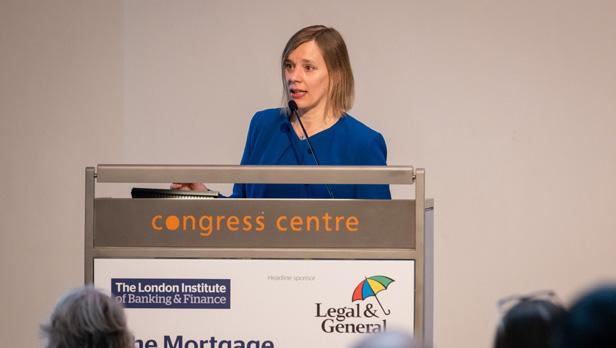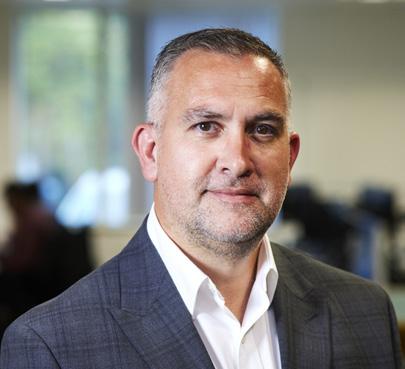


MORTGAGE INTRODUCER Champion of the Mortgage Professional www.mortgageintroducer.com May/June 2023 FACE TO FACE Meeting to maximise business PLUS: ELITE WOMEN 2023 Celebrating the industry’s best

We know that every case is different and whilst some lenders may not be able to help, we see the potential and cut through complexity. Our strength lies in our flexible common sense approach with a willingness to consider cases that fall outside of our standard criteria. Our underwriters individually assess each case enabling us to find tailored solutions for your buy to let and residential clients. The home of mortgage solutions andcr a fted pecialist BUY TO LET AND RESIDENTIAL MORTGAGES Flexi b le CRITERIA AND UNDERWRITING Individual CASE ASSESSMENT Empowered NATIONAL BDMs TO SUPPORT YOU andcr a fted Call us today on 01634 888260 or visit krfi.co.uk to find your BDM. FOR INTERMEDIARIES ONLY Information correct at time of print (10.05.2023) 03-09-01 - MKT001747-005
Global managing editor
Paul Lucas paul.lucas@keymedia.com
Editor Simon Meadows simon.meadows@keymedia.com
News editor
Jake Carter jake.carter@keymedia.com
Senior news writer Rommel Lontayao rommel.lontayao@keymedia.com
Commercial director Matt Bond matt.bond@keymedia.com
Campaign coordinator Raniella Alonzo raniella.alonzo@keymedia.com
Vice president, sales Chris Anderson
Vice president, production Monica Lalisan
Production coordinators
Kat Guzman & Loiza Razon
Content editor Kel Pero
Designer Khaye Cortez
President & CEO, Tim Duce Director, people and culture, Julia Bookallil
HR business partner, Alisha Lomas-Oliver
Chief information officer, Colin Chan
Chief revenue officer, Dane Taylor
Global CEO, Mike Shipley
Global COO, George Walmsley

May the forces be with you
“Growth is never by mere chance; it is the result of forces working together.”
So remarked James Cash Penney, an American businessman and entrepreneur who founded the hugely successful JCPenney stores in 1902 – nearly 700 of which still operate today across the United States and Puerto Rico.
One suspects that Penney would have approved of the intent behind Mortgage Business Expo North in Manchester and The Mortgage Conference, hosted by the London Institute of Banking & Finance (LIBF) – two key events that recently brought together hundreds of professionals from across the industry.
At a time when many of us are working on our own, coming together under one roof (or in this case two) to shake hands and look each other in the eye in a way that had seemed inconceivable just a couple of years ago can only be a good thing.
When you’re in the presence of others who share a goal with you, the energy generated by that meeting of minds is palpable; the potential to do business and learn from each other is compelling.
KM Business Information UK Ltd
Signature Tower 42, 25 Old Broad Street Tower 42, London EC2N 1HN www.keymedia.com
UK ∙ Canada ∙ Australia ∙ USA ∙ NZ ∙ Philippines
Mortgage Introducer is part of an international family of B2B publications, websites, and events for the mortgage industry

CANADIAN MORTGAGE PROFESSIONAL cmpadvertise@keymedia.com
MORTGAGE PROFESSIONAL AMERICA mpaadvertise@keymedia.com
MORTGAGE PROFESSIONAL AUSTRALIA claire.tan@keymedia.com
AUSTRALIAN BROKER simon.kerslake@keymedia.com
NZ ADVISER alex.knowles@keymedia.com
Copyright is reserved throughout. No part of this publication can be reproduced in whole or part without the express permission of the editor. Contributions are invited, but copies of work should be kept, as the magazine can accept no responsibility for loss.
So, in this edition of Mortgage Introducer, we traverse the many miles between Manchester and London to gauge the mood, north and south, of an industry getting back on its feet after the unsettling rollercoaster ride of recent months. You’ll find wise words aplenty in our account of the two events, including a dedicated section on a fascinating conference discussion about the current fortunes of specialist finance.
We also profile two successful women whose achievements should inspire others to follow in their footsteps. Kate Davies shares her industry insight as executive director of the Intermediary Mortgage Lenders Association (IMLA), while Sarah Stroud shares her take on the market as a director at Truffle Specialist Finance. As Stroud says, “When you see more women in senior positions, such as at board or CEO levels, that will then hopefully increase the number of role models and mentors available to young women and encourage them to a career in this industry.”
Interestingly, both could have taken different paths – Davies studied music at university, and Stroud had been set for a career in law. The potential loss to the music and legal worlds is arguably the mortgage sector’s gain.
Simon Meadows
www.mortgageintroducer.com MAY 2023 MORTGAGE INTRODUCER COMMENT
EDITORIAL 1









MORTGAGE INTRODUCER MAY 2023 www.mortgageintroducer.com WHAT’S INSIDE MAGAZINE Contents 4 Market review 10 Advice review 14 Network review 15 Recruitment review 16 Technology review 20 General insurance review 23 Equity release review 24 Protection review 30 Cover Feature Conferences: North and South 34 Interview: Kate Davies IMLA’s ED talks to MI 37 Special Report Women who are leading the way in the UK mortgage industry 44 Interview: Sarah Stroud Showing how it’s done 46 Specialist Finance Introducer Talking with experts and more in the buy-to-let specialist market 54 Loan Introducer The latest from the secondcharge market 56 Feature Tracey Ezard on leadership 2 15 WINNING WOMEN 37 FEEDBACK 10 46 WISE WORDS THE SPECIALISTS Cover photo: LIBF





Strong lending appetites and innovative solutions support borrowers

lowest at 2.9 per cent.
Increased market and economic stability experienced over the back end of Q4 2022 and Q1 2023 has continued into Q2, and the additional confidence this has generated has filtered into the mortgage market to help generate rising levels of competition across all sectors.
This has led to some slow but steady downward pressure on mortgage rates and a slight uptick in purchase business to help bolster activity levels for intermediary firms that have relied so heavily on the remortgage sector in recent months.
UK HOUSING MARKET
According to the latest UK House Price Index from the ONS and Land Registry, average UK house prices increased by 5.5 per cent in the 12 months to February, down from 6.5 per cent in January.
The average UK house price was reported to be £288,000 in February, £16,000 higher than 12 months ago, but £5,000 below the recent peak in November 2022. Average house prices were said to have increased over the 12 months by six per cent in England, 6.4 per cent in Wales, one per cent in Scotland, and 10.2 per cent in Northern Ireland.
On a regional basis, the West Midlands saw the highest annual percentage change of all English regions in the 12 months to February 2023 at 8.6 per cent, while London saw the
I’m going to remain firmly on the fence when it comes to any house price predictions, given the unprecedented events over the past few years, but what I can say with more confidence is that these events have also cemented just how robust the UK housing market continues to be.
AFFORDABILITY
Turning our attention to affordability, a Housing Affordability in England and Wales: 2022 report from the ONS, published in March, outlined that full-time employees in England could expect to spend around 8.3 times their annual earnings buying a home in 2022. The report also showed that the equivalent figure in Wales was 6.2 times annual earnings. While the 8.3 is down from the 9.1 times earnings figure from the previous year’s survey, the 2021 figures have been attributed to a sharp increase in prices due to changes in stamp duty land tax and land transaction tax.
Across England and Wales in 2022, housing affordability was reported to have improved in 235 areas, worsened in 89, and stayed the same in the remaining six. The most affordable areas in 2022 (where the ratio was less than five times earnings) were in the North West, Wales, and the North East.
In 1997, 89 per cent of local authorities had an affordability ratio of less than five times workers’ earnings, whereas only seven per cent had this level of affordability in 2022.
With house price growth considerably outstripping wage growth over a significant period, in addition to interest rates rising and living costs escalating in more recent times, affordability
has become ever more constrained. On a positive note, lending appetites are strong, and a range of innovative, responsible, accessible solutions and initiatives is emerging to assist a range of borrowers in overcoming these affordability obstacles.
REMORTGAGE
In March, the number of remortgage instructions was reported to have grown by 28 per cent, although there was a slight increase in cancellation rates and a drop in completions. According to LMS’s Monthly Remortgage Snapshot, there were seven per cent fewer remortgages completed in March, and the overall cancellation rate increased by 1.36 per cent. However, the firm said that pipeline cases have grown by nine per cent month-on-month, and added that this trend was set to continue for the rest of the year.
This data also outlined that a big build in instructions and pipelines is expected as the year goes on, with a raft of product expiries leading to the “highest ERC spike for five years at the end of Q4.” This is a prediction that demonstrates the ongoing value of the remortgage sector and the importance of maintaining close contact with existing client banks to support them in their ongoing needs. M I
References:
https://www.ons.gov.uk/economy/ inflationandpriceindices/bulletins/housepriceindex/ february2023
https://www.ons.gov.uk/ peoplepopulationandcommunity/housing/bulletins/ housingaffordabilityinenglandandwales/2022
https://corporate.lms.com/wp-content/ uploads/2023/04/LMS-Remortgage-SnapshotMarch23.pdf
MORTGAGE INTRODUCER MAY 2023 www.mortgageintroducer.com 4
REVIEW MARKET
Martin Clift head of intermediary services & transformation, Barclays









































































































Regulator’s retrofit expectations made clear
making it difficult, or very expensive, for properties with lower energy efficiency to secure a mortgage.
the industry with the certainty to progress toward achieving an ambitious goal.
Despite an absence of clear direction on EPC regulations in the PRS, regulators are adamant that the industry must provide the support necessary to facilitate the decarbonisation of UK homes.
The threat of climate change has an increasing influence on businesses across all sectors, and financial services is no exception. It was interesting, then, to hear the FCA’s take on the place of mortgage lending as the UK transitions to net zero.
Speaking at the London Institute of Banking & Finance mortgage conference recently, David Geale, director of retail banking at the FCA, highlighted that the industry has a part to play in supporting the decarbonisation of the UK’s housing stock.
Although Paragon’s Raising the Standards of Privately Rented Property report recently revealed that the last decade has seen a 165 per cent increase in the number of privately rented homes with an EPC rating of A to C, we know that this is primarily driven by an influx of greener homes into the sector, which has diluted the less energy-efficient properties.
Geale addressed this point, warning lenders against taking a narrow approach whereby mortgages are only written on newly built and generally more energy-efficient properties.

Such an approach may help to “green” an organisation’s balance sheet, but won’t help to decarbonise the UK’s housing stock – and could have the unintended consequence of
But research cited by Geale highlighted how with this challenge comes opportunity – 98 per cent of all current stock has the potential to make EPC A, B, or C if all feasible energy improvements are made.
Under the current proposed timescales of 2025 for new tenancies and 2028 for existing rentals, it is estimated that over 4,000 properties would need to be upgraded per day to hit the deadline. Any fresh date proposed by government needs to consider the supply chain required to achieve its goal.
While borrowing to undertake refurbishment works is something that landlords have done for some time, it could seem surprising that the development of finance products specifically aimed at improving the energy efficiency of portfolios is an area of the market that still requires a solution.
Despite the sense that we’ve been talking about proposed changes to EPC regulations in the PRS for some time – so much so that it’s being talked about as if it were law – we still await clear direction from government. While it is encouraging to see that any changes are being carefully considered by policymakers, both lenders and borrowers are currently in the position of knowing that properties need to become more energy efficient, but being left in the dark on aspects that are fundamental to achieving this.
The most obvious example here is a date for when any new regulations are likely to come into force, something that would provide
As anyone who has tried to improve their property over the past year or two knows, tradespeople are in high demand and short supply. And even if we find people to undertake the improvements, how do we know the work will be carried out to a high standard and that the technology will be reliable and deliver the benefits we’ve been sold?
We’ve seen how some of the approximately 250,000 homes estimated to have spray-foam insulation have had to pay for it to be removed after it was found to damage roofs and lofts. While insulation of this type was clearly well intentioned, this has become an energy-saving measure that many lenders are reluctant to finance, and we’ve heard of borrowers struggling to mortgage properties where it has been used.
This is an example where advice could have highlighted the potential negative impact of the upgrades. While it wouldn’t be reasonable to expect financial services professionals to be experts in energysaving technology and construction methods, gaining a good understanding of the products that may be quite different from anything else that borrowers have seen before will enable brokers to support landlords in creating the sustainable homes of the future. M I
MORTGAGE INTRODUCER MAY 2023 www.mortgageintroducer.com 6
REVIEW MARKET
Richard Rowntree CMD, mortgages, Paragon Bank
Any fresh date [for EPC regulations] proposed by government needs to consider the supply chain required to achieve its goal
Specialist lending is made for these times
We are now well into a period where, historically speaking at least, activity levels across the housing market have tended to increase, with mainstream-purchase business largely dominating.
The nature of the UK housing market means that this type of business will always remain prominent. However, in the wake of additional financial burdens being placed on first-time buyers, secondsteppers and later-life borrowers – in addition to rising affordability concerns, criteria changes, complex income calculations, risk appetites, and many more influencing factors –demand is rising for more specialist residential options.
This trend is also affecting an advice process that has previously lent heavily on a predominantly vanilla, fixed-rate churn, meaning it’s little wonder that a growing number of advisors are realising the value of trusted packaging partners in helping them and their clients to navigate some challenging economic and lending conditions.
COMPLEX RESIDENTIAL
When faced with the question of what their biggest challenge will be in 2023, a survey of more than 500 brokers conducted by Pepper Money found that nearly 26 per cent of brokers were concerned about finding a mortgage for customers with adverse credit in the year ahead.
The next-hardest area in which
to place cases, according to nearly 22 per cent of brokers, would be buy-to-let (BTL), with remortgaging at high LTVs viewed as the most challenging by nearly 12 per cent of brokers. Just over 11 per cent of brokers said they expected to have trouble finding a mortgage for their self-employed customers and those with complex incomes, while nearly 10 per cent thought they would struggle to find a mortgage for first-time buyers. Just under nine per cent were most concerned about accessing a mortgage for older customers nearing retirement.

These highlighted areas are valid concerns in the intermediary community, but a wide range of options remains available, especially from those lenders who maintain a more flexible underwriting approach and have the ability to take individual circumstances into account when assessing a variety of property-related transactions.
BUY-TO-LET
This is also the case in a buy-to-let sector that has become even more multifaceted in recent times due to increased levels of activity around portfolio landlords, limited companies, MUFBs, HMOs, and other more complex lending scenarios.
Questions continue to be raised over the future of BTL following rising rates and increased stress testing, but this remains a robust sector, and demand and opportunities are still out there. March 2023 even saw the highest-ever volume of buy-to-let mortgage searches on the Twenty7tec platform in a single month.
The data showed that 347,419 searches for buy-to-let mortgages were handled over the course of the month, representing a 12.6 per cent increase on the volume of searches in
February. Translating these searches into cases is another matter, which again emphasises the importance of the role played by packaging partners in helping to facilitate more intricate and time-consuming enquiries.
BRIDGING
As the BTL sector moves in an increasingly professional direction, we are seeing it form an even closer relationship with bridging finance as a facility to help landlords take advantage of a property market that is experiencing something of a lull. From helping them purchase a new portfolio addition at an auction through to raising funds to make improvements on existing properties as an alternative to locking into a remortgage rate, this is an association that is helping to bolster the volume of bridging business being written.
March saw Together lend more than £115m of short-term finance across its commercial business, a record in its 49-year history and an 8.5 per cent increase on its previous record of £106m, set in May last year. Its group lending in March topped £256m across its commercial and personal finance business. In addition, the OSB Group’s gross bridging loan book was reported to have increased by almost £100m in 2022, and Signature Property Finance posted a record first-quarter lending figure of £26.6m.
With data from the Association of Short Term Lenders (ASTL) for Q4 2022 also showing that bridging applications and loan books continued to grow over the quarter by 9.1 per cent compared to Q3, at a value of £8.6m, this further emphasises the growing demand attached to bridging finance, and the value of being able to access a variety of specialist lenders who can meet borrowers ever-shifting needs.
www.mortgageintroducer.com MAY 2023 MORTGAGE INTRODUCER 7
M I
REVIEW MARKET
Donna Wells director, Envelop
Self-employment needs all our support
The rising number of selfemployed workers has been something of a bellwether for recovering economic confidence over the past 20 years.
In the run-up to the dot-com bubble in the early 2000s, when tax reform under Tony Blair and Gordon Brown spurred considerable investment across the economy, the number of people leaving paid employment to set up on their own began to climb. That trend has continued broadly for two decades, with two notable exceptions to its steady rise. The first came in the wake of the global financial crisis and collapse of Lehman Brothers in 2009; the second was triggered by the pandemic.
Analysis carried out by the Office for National Statistics suggests that, quite logically, when faced with uncertainty, people flock to safety – a steady job, in other words. Its figures show that before COVID took hold, self-employment in the UK had been steadily increasing, peaking at five million people in October to December 2019 – a very significant 15.3 per cent of total employment.
Since then, the numbers have fallen considerably, down to just under 4.2 million in October to December 2021 – just shy of 13 per cent of total employment, and the lowest level in the previous eight years.
More recently, that decline has begun to reverse. In the first quarter of 2022, there was a slight increase
to just over 4.2 million people in self-employment – a small but nonetheless significant rise. The ONS’s analysis of self-employment published in 2016 found increasing levels of self-employment between 2008 and 2015 to be one of the defining characteristics of the UK’s economic recovery.
From the data, it looks possible that we may be at the start of a similar recovery.
In January to March 2022, net flows into self-employment from other labour market statuses were all positive: 39,000 from employees; 17,000 from unemployment; and 38,000 from economic inactivity, totalling 95,000.
We all know the economy is under pressure, as inflation rose again in February, which wasn’t something the Bank of England expected. March saw the Monetary Policy Committee raise the base rate another 25 basis points, taking it to its current 4.25 per cent
But we should not overlook an important point. The speed with which GDP recovers is material, but so are the needs of the people producing it. Confidence and growth come from all of us feeling a bit safer each day. After three years of safety mode, there are finally tentative signs that the entrepreneurially spirited are going back to work for themselves.
This matters for us in the mortgage market because all businesses and individuals benefit from a growing economy. But for these stirrings of confidence to thrive, we in the mortgage sector also have a responsibility not to leave those in charge of small businesses across the UK unsupported.
Becoming self-employed takes courage – not just to go it alone but also because our financial system so often fails to keep pace with changes in
society and the economy’s structure. Less-adequate pension provision, no sick pay or paid leave, no health insurance – the challenges facing those becoming self-employed for the first time are not just commercial, they are personal, too, particularly when it comes to securing a mortgage. Having the stability of homeownership and the confidence that self-employment will not compromise that stability is absolutely critical for economic recovery.
Yet we know that it’s long been the case that being a newly selfemployed borrower has proven far more challenging than being a borrower who has just started a new job. Ten years ago, evidencing affordability in line with Mortgage Market Review guidelines was new, and lenders were bruised or battered by the credit crunch and consequent Basel capital adequacy crunch. Neither of those things is problematic today. Banks and building societies are well capitalised and lenders have learned how to assess self-employed applicants.
There is a lot more that the industry could be doing to reframe how customers view their prospects when becoming self-employed. We have to change the perception among Britain’s self-employed and those considering starting out on their own that doing so will make becoming a homeowner impossible – at least for the first few years – because it’s not the case anymore.
Getting a mortgage when selfemployed is as easy or challenging as getting a mortgage with a job; to secure either, you need to understand how best to present the information. The approach for one isn’t harder than the other; it’s just different.
And it’s something I’m pleased to say we at Newcastle Building Society excel at. M I

MORTGAGE INTRODUCER MAY 2023 www.mortgageintroducer.com 8
REVIEW MARKET
Michael Conville CCO, Newcastle Building Society
Come inside! Opening doors in Seconds

Our flexibility and willingness to consider various factors when reviewing an application, including adverse credit, allows our brokers to open more doors for their Second Charge borrowers. Biometric facial recognition and instant online DIPs mean your cases can progress in seconds!



UTB MORTGAGES FOR INTERMEDIARIES
understand specialised mortgages T: 020 7031 1551 E: mortgages.enquiries@utbank.co.uk This information is strictly for the use of professional intermediaries only.
we
here to register and
broker
Scan
access our
portal
Developing your skills in readiness for consumer duty
need to develop your ability to test understanding – then record how you’ve done so.
For many advisors, consumer duty is a principle shrouded in mystery.
In its simplest terms, consumer duty requires firms “to act to deliver good outcomes for retail customers.” For this to happen, advisors need to understand that they are accountable for their own competence and cannot simply rely on the training provided by their employer or network.
WHAT CONSTITUTES COMPETENCE – AND WHAT CAN YOU DO TO DEVELOP IT?

Competence is the ability to do something well. It requires a combination of knowledge, skills, capacity (including having the tools necessary for the job), and the right attitude. It is developed through a range of interventions, including training, coaching, observation, and experience. Whilst many of these may be provided by your employer or network, what you actually learn is up to you.
What consumer duty makes clear is that there will be an expectation of heightened levels of advisor competence. For example, it is no longer enough to simply communicate clearly with your customer. You need to be able to assess and document the customer’s understanding of what you communicate. Yes, this will require many basic skills, including listening, questioning, summarising, and signposting, but to truly prove understanding, you will
This might mean using a different style of questioning. It might mean asking customers to tell you what they understand and recording their answers. Maybe you have always done this. But have you pushed the boundaries farther by asking them to interpret what you’ve told them, or to explain how different circumstances may affect things?
The good news is that there is no expectation for customers to understand everything about a product. But they must understand the salient points, including why it is right for them and the risks attached, and there must be evidence of this understanding.
So, what is meant by evidence, and how do you gather and collate it? The regulator has not been specific about what it expects. However, it’s likely to be a mixture of client-specific and broader management information.
How can you demonstrate that the product you have recommended is suitable for your client and supports their financial objectives?
How do you show that the client has understood the product you have recommended and why you have recommended it?
How do you demonstrate that your charges represent fair value for the service you have provided?
How do you show that the overall balance of products you have recommended is appropriate for your customer base?
How do you evidence the persistence of the products you have recommended?
Obviously, producing and storing this type of data will require effective processes and systems. But, as an advisor, you must also have the skills to record the right data and interpret any relevant information appropriately. Regardless of whether you are directly authorised or an appointed representative, this may demand skills you do not currently have.
Things are further complicated when you consider vulnerable or potentially vulnerable customers. Recent data suggests that most of us are likely to be vulnerable or potentially vulnerable at least once in our lives. During these times, our capacity to understand complex information and make good financial decisions may be significantly reduced. Consumer duty makes it clear that advisors need the skills to identify and support these customers to achieve the same quality of outcome as any other person.
Once you acknowledge the heightened levels of competence you are expected to demonstrate, you may realise that you need to further develop your skillset. As I said earlier in this article, you cannot wait for development opportunities to be presented to you. You must identify your own learning needs and seek solutions.
The great news is that there are plenty of resources available to support your development. You don’t need to look for those labelled “consumer duty,” but what you do need to do is carry out an honest and thorough appraisal of your current skills against those you’re likely to need in the near future. There are many learning and development tools to support you with this. And, of course, as a starting point, you could ask colleagues, customers, and supervisors to provide feedback on what you do well and what you could be even better at.
MORTGAGE INTRODUCER MAY 2023 www.mortgageintroducer.com 10
M I
REVIEW ADVICE
Gordon Reid business and development manager, London Institute of Banking & Finance
Give me the keys to the DeLorean
dream home, not just the first step on the ladder?
Well, those days are gone, at least for now. So how do you approach the conversation in such uncertain times?
Everyone’s talking about interest rates, and with the current costof-living crisis, many clients are wanting guidance on how to find the best rates.

It’s human nature to seek the best deal – hence the existence of countless comparison sites – but as professionals, we know mortgages are far more complex than just looking at the best rate.
In the last 12 months, we have moved from a low-interest, decreasing-rate environment to interest rates higher than we have seen for a decade. Mortgage rates are still changing constantly, causing worry and uncertainty for our clients.
If you have started advising in the last 10 years, you may have only ever seen rates falling before last year. Isn’t it awesome when you can advise a client upon remortgage that their rate and monthly payment are going to fall? Or talk to a first-time buyer about their affordability and get them to that
I sometimes find myself wishing for the DeLorean from Back to the Future, so I could time-travel like Marty McFly. Sadly, without a time machine at our disposal, it’s hard to make any useful predictions. When clients ask where interest rates will be in two, five, or ten years, it can be tempting to answer. After all, mortgages are our business, and we want to seem knowledgeable and confident.
But I always resist that temptation for the following reasons:
1. Inaccuracy: Mortgage rates are influenced by a variety of factors. These factors can change rapidly and unpredictably, making it difficult to predict rates accurately over the long term. Even minor errors in predictions can have significant consequences for borrowers.
2. Legal and ethical considerations: Being regulated by the Financial Conduct Authority (FCA), we are required to comply with strict guidelines regarding advice given to clients. Providing inaccurate or misleading information can lead to
regulatory action, complaints, and reputational damage.
3. Client expectations: Predicting mortgage rates can create unrealistic expectations among clients, who may expect you as an advisor to have insider knowledge or special expertise in predicting the market.
4. Time and resource constraints: Predicting mortgage rates can be time-consuming and resourceintensive, requiring extensive research and analysis.
So, what should influence those conversations, and what should be considered when advising clients on interest rates? Quite simply, the client’s situation and future plans.
Your recommendation to a first-time buyer is likely to look very different from that given to a family with young children, or an investment client looking to maximise their portfolio.
Whether a short-term or long-term interest rate is suitable for a client, in the same way as whether a fixed rate or tracker is suitable, will come down to your client’s situation, preferences, and life plans.
That’s why it’s so important to know your client and listen to their expectations.
Of course, we can make an educated guess by looking at the SWAP rates and market expectations, but all predictions are risky. So, until you have the keys to the DeLorean, it’s best to stick to what we do best as advisors – giving advice based on your client’s situation. M I

www.mortgageintroducer.com MAY 2023 MORTGAGE INTRODUCER 11
REVIEW ADVICE
Hannah Bashford mortgage & protection adviser, Model Financial Solutions
It’s human nature to seek the best deal ... but as professionals, we know mortgages are far more complex than just looking at the best rate
Firms need to choose wisely if they want sustainable technology outcomes
Over the last 20 years, our lives have been turned upside down by the advances in digital, mobile, and, more recently, artificial intelligence. In business, and specifically throughout the mortgage value chain, the change has been slower, but profound nevertheless.

I think we are largely past the notion that companies need to invest in technology to remain relevant. The pandemic afforded businesses in financial services a window into a technological world that may otherwise have remained more distant than it is today.
As we emerged from the pandemic, the pressure on interest rates and affordability meant unfamiliar stresses on systems and process from the era of historic low interest rates highlighted again how more nimble and agile technology was no longer optional for a future in which anything can and often does happen.
The subsequent investment in technological change to support this new world, whether that be working from home, hybrid, or slicker digital access to market, has been in this context as inevitable as it has been widespread. Technology providers are not short of interest or projects.
In technology investment terms, this is producing some interesting outcomes. Dissatisfaction with legacy providers is at an all-time high, if my conversations
are anything to go by – so change is on the table. One outcome is that this environment understandably increases the attractiveness of outsourcing provisions. But that also outsources the problem. In one recent study from earlier in the year, 77 per cent of businesses globally reported difficulty in finding the talent they need, with this problem particularly evident in the UK. Eighty per cent of businesses in the UK reported issues with filling vacancies.
The subsequent rise in cost pressures is almost certainly making some legacy contracts feel very burdensome indeed. The costs of delivery have soared, and it is interesting how few lenders I speak to have really understood the forward financial viability of the organisations they choose to work with.
The result is that even if the rise in costs is not terminal for a small lender or technology provider, it can slow big projects as providers seek to balance the cost of winning the job with the cost of delivering it. From the lenders’ point of view, the talent and experience shortage can affect their understanding of what a good deal at this point really looks like. It takes experience to pick apart and understand the impact of a cocktail of conflicting issues, such as the squeeze on margins and the focus on price; the need nevertheless to deliver a solution of some description; the lack of experience and expertise that can result in a failure to specify requirements properly; the need to understand how to appoint, and on what terms, in this market; and how competition amongst tech providers can result in cut prices and/or cut corners. All this can make reaching the right decision rather more difficult than it might appear.
When you think about it, if you
are not paying much for something, it may feel like a bargain – but it shows how much you really value it and the provider of that service. If a provider has others paying more (or at least a sustainable market rate), you cannot expect to be top of the Christmas card list, or to receive much in the way of gratitude at all.
The truth is, as in so many industries, if a model isn’t sustainable, businesses go bust. And in the technology world, that is really expensive and really risky, because you have to find a new provider, implement a sizeable programme to determine requirements, effect the change, and migrate the data, while still delivering BAU on an old system that’s no longer supported.
The pressures in the economy are coming from all sides. Firms need to invest and do so quickly, but the changes can vary quickly and the cost of delivery to the provider may very well be volatile. This requires a calm head to put the right deal in place.
Outsourcing has become a complex issue. Lenders have plenty to think about, from assessing internal and external supplier risk (which includes sub-outsourcing), to revised requirements for governance and record-keeping, to the negotiation and recording of the actual outsourcing agreements, or from data security to access and continuity and exit plans. There is a lot to cover.
The solution is to be clear on detailed requirements, source the right provider, contract on the right basis in a way that’s sustainable for everyone, and then implement the change in the most efficient manner possible. Realistic and achievable expectations are truly paramount. M I
MORTGAGE INTRODUCER MAY 2023 www.mortgageintroducer.com 12
REVIEW ADVICE
Tim Hague MD, Sagis
Protecting homes, investments and reputations.
Done properly, spray foam insulation is a safe, effective and long-lasting way to insulate homes and properties.
Scan the QR Code to find out how we are driving surveyor confidence through quality products and professional excellence.

BBA AND KIWA ACCREDITED FULLY AUDITABLE DOCUMENTATION AUTHORISED INSTALLER NETWORK
With spray foam insulation, we’ve got it covered.
We are all involved with helping clients now
Look how far we have come in the way we, as an industry, treat customers. While many of us would like to believe that individually we have always treated customers as we ourselves would like to be treated, it is clear when we compare the attitudes and methodology that prevailed before the credit crunch to today that the approaches could not be more different.
There is no greater example of this change than the way in which people in trouble trying to pay their mortgage are now treated. While individual lenders have always offered some degree of forbearance, in the wake of the 2008 credit crunch, regulation has, after a series of initiatives, effectively codified what consumers can expect by way of assistance from their lenders if they fall into arrears.
It is worth noting that up until 1995, the government used to cover interest payments on behalf of mortgage holders who had lost their jobs or were on supplementary benefits, within certain limits. Of course, we are talking about a time when the political accent was on persuading the public to buy property and included incentives such as MIRAS (mortgage interest relief at source), a scheme introduced in 1983 that allowed borrowers tax relief for interest payments on their mortgages.
The look back in history serves the purpose of illustrating just how the
landscape has changed, politically and economically, since those days when the imperative for government was to push home ownership. As economic conditions worsened, incentives such as MIRAS and government assistance in the event of job loss were withdrawn. By the time of the credit crunch and its aftermath, a fair proportion of that generation of homeowners still believed that they were eligible for government help. In 2006 a survey stated that around one in 12 people surveyed said they thought the government would pay their mortgage if they were unemployed while another three million did not know whether it was the homeowner or the government who would keep up payments if they could not work.
Back to today, and the onus for helping mortgage holders lies squarely on lenders via regulator-mandated forbearance, but also by making brokers responsible for customer outcomes under the upcoming consumer duty guidelines. This draws us all into making sure that customers are looked after properly, especially those who are struggling.
The onus seems to rest on lenders to show forbearance, by granting temporary “payment holidays” or reduced payments, extending the term of the mortgage, switching to interest-only for a temporary period, or moving to a different interest rate/product. However, what could be forgotten is the active role that introducing brokers can play, especially because we are more likely to have had more immediate contact with our customers than the lender would have in normal circumstances.
At this time of pressure on family budgets because of rises in the cost of living, I would urge all brokers to make a particular effort to be in
touch with their clients and make sure that none of them are either in difficulties or are worried that they might be getting to that point.
I think we can all agree that the old method of working solely in the present is now dead, as is the idea that, having completed a case with a new client, we can safely leave them to their own devices while we concentrate on finding new clients.
Most brokers are aware of how valuable their existing clients are to them as a source of referrals and new business. If not, the imminent arrival of the consumer duty protocols, on top of the ongoing commercial imperative not to let clients choose to go to another source for their next mortgage or insurance product, should certainly have sharpened the outlook of any broker who is still reluctant to follow up with clients.
The truth is that any brokers worthy of the name who genuinely see a long-term career ahead of them will be getting behind the concept of contacting clients old and new in order to stand ready to assist them if any of them are in difficulties.
Acting as a go-between to the lender and the client, brokers can provide a clear story to the lender that is more likely to elicit a positive response in the first instance. M I

MORTGAGE INTRODUCER MAY 2023 www.mortgageintroducer.com 14 REVIEW NETWORK
Shaun Almond MD, HL Partnership
In the wake of the 2008 credit crunch, regulation has, after a series of initiatives, effectively codified what consumers can expect by way of assistance from their lenders if they fall into arrears
Feedback on feedback
precisely did the candidate answer the questions being asked – did they go off on tangents that were not appropriate? How well did the candidate research the company and explain how and why that research had created a genuine interest in the role and organisation?
Employers are not legally required to give candidates feedback following interviews. Yet it is the right thing to do, being both respectful of the candidates’ time and a real reflection of the culture of the recruiting firm. I strongly believe that even if the outcome isn’t a positive one, there should always be something actionable to take away from an interview process.
Good-quality feedback demonstrates cultural values such as honesty and integrity and will encourage candidates to reapply for roles with a company in the future, whilst undoubtedly shaping how favourably an individual will speak about that brand as well. Reputation is everything in a digital world where word of mouth spreads fast, so consider how your brand is being affected if you constantly give little or vague feedback.
Firms that respect candidates enough to provide useful feedback after interviews stand out. Constructive feedback is given far more frequently to internal candidates, with external candidates often receiving intangible feedback such as being not quite “the right fit.” Similarly, “We have offered a stronger candidate the position” is worth little without more prescriptive reasons why a person didn’t score as highly as others.
Put yourself in the shoes of others. Consider the feedback you would like to receive and provide it for others. Empathy is necessary when evaluating anyone after an interview. Providing feedback that focuses on the role and offers improvement tips is more empathetic than vague advice –constructive feedback gives value to the hiring experience.
How often have you given or received feedback that detailed two things that were done well and two things that could be improved upon? If it can’t be acted upon, it’s not useful. Actionable feedback is empathetic and practical. Being precise significantly improves the value of feedback; vagueness does not.

It may be that a candidate didn’t have a compelling answer as to why they wanted to join the firm. Maybe they need to work on keeping their answers succinct, or need to go into interviews with more demonstrable examples of expertise in a specific area.
Certainly, if you are interviewing a number of candidates, I advocate referring to your notes immediately after the interview (you won’t always be in a position to make a decision straight away, but should start collating feedback and comments before seeing others, even if it is not used immediately), and I advise breaking down feedback into sections.

For example, how effectively did the candidate demonstrate the technical competency to do the job? How
The American poet Maya Angelou observed, “People will forget what you said, people will forget what you did, but people will never forget how you made them feel.” This is very true when it comes to how post-interview feedback will mentally embed a view of a firm in a person’s mind.
If a candidate is told only that they are “not a good fit,” they have every right to assume that the hiring manager didn’t want to spend the time to provide proper constructive feedback – or, more likely, that such a banal statement is a cover for some unconscious bias/discrimination and that any pretensions or claims to desire a wider diversity of thought and a fresh perspective are merely for effect.
A note of caution for firms is that whilst feedback is not legally required, under GDPR, candidates have the right to access their data. That means they have the right to access and receive a copy of their personal data and any supplementary information via a subject access request (SAR).
Typically, this right is there to make transparent how and why organisations are using their data, and to check whether they are doing it lawfully, but it can also extend to job candidates sending SARs requesting a firm’s interview notes about them. So if you want to find out exactly why you weren’t hired for the job, you should be able to access internal scoring sheets, application criteria, and interview notes.
If the selection process is well thought through and professionally delivered and the interviewers are suitably skilled, there shouldn’t be anything to hide when making selection decisions (internal or external), since the reason for the hiring decision will be evidence-based. M I
www.mortgageintroducer.com MAY 2023 MORTGAGE INTRODUCER 15
REVIEW RECRUITMENT
Pete Gwilliam owner, Virtus Search
Urgent and important: the role of technology is growing
Technology has often been viewed as the expression of change in financial services, but it is now an intrinsic part of managing regulatory and market change. It is part of the operational model itself.

Last month we were very proud to announce that we have partnered with Dudley Building Society to help them provide a truly modern service to intermediaries. Using our softwareas-a-service (SaaS) platform, Dudley will transform its digital offering for both customers and brokers. The move is transformative.
There is a real opportunity to enhance lenders’ intermediary experience through the digital innovation of originations platform like our own to improve the digital intermediary experience, increase speed, efficiency, and productivity, and propel lenders’ intermediary experience to the forefront.
Many lenders are either on the path of or looking to invest in delivering fundamental transformation to their operating models. It is a testament to how easy it can be to transition from a traditional model to one that is agile enough to cope with constant market and regulatory change.
The past three years have shown us just how vital it is to be able to react quickly and accurately to shifts in the market. The pandemic lockdowns and the necessity for remote banking – and working – brought home just how quickly the business environment can change. Last
autumn’s mini budget will go down in history after its uncosted policy proposals crashed the pound and bond market and ultimately forced 40 per cent of all mortgage products to be withdrawn for repricing. We are now all too aware of how fundamental to survival the ability to flex can be. Now we’re heading for yet another seismic event. At the end of July, the Financial Conduct Authority’s consumer duty rules will come into effect, necessitating a sea change in the way both advice and mortgage approvals are assessed –and, importantly, evidenced. It’s a point that often gets lost during the excitement about re-inventing the origination experience, but the regulatory focus upon good outcomes for borrowers will require an evidence trail that agile platforms can quickly provide. We might all be complying in spirit and deed, but we will need to prove it.
Flexible technology that allows this evidence to be collected, stored, and accessed easily will not be a niceto-have – it will be a prerequisite for lenders facing increased scrutiny from the regulator. It is also the case that all lenders are equally exposed to this scrutiny – as are all intermediaries. For there to be trust in the lenderbroker relationship, there has to be confidence that customers are receiving both advice that satisfies consumer duty and the product that delivers what they need. The past year has been hard, especially on the back of two years of pandemic social restrictions. Lenders have been contending with pricing volatility, rising interest rates, and more customers struggling to cope with the rising cost of living. The distractions and immediate needs have been many.
But with just three months to go before consumer duty kicks in, being
ready is now a priority. As the late US president Eisenhower famously said, “What is important is seldom urgent and what is urgent is seldom important.” There is a window in which the important can be dealt with urgently with the right platform and business model to support the right kind of change. It’s the beauty of SaaS platforms – the turgid admin of customising systems designed so long before they are implemented is simply not there. It’s also our responsibility to keep abreast of the constantly changing regulatory environment. That takes a considerable amount of compliance pressure off the day-today business of lending. And that’s good for business.
In February, the FCA sent Dear CEO letters out to all lenders and mortgage administrators, reminding them of the “significant shift” in its expectations of all firms. “We expect the Consumer Duty to be a top priority for you personally,” the letters said. “We want good outcomes for customers to be at the heart of firms’ strategies and business objectives. Firms’ boards and senior management should embed the interests of customers into the culture and purpose of the firm.” The responsibility is clear, and it is imminent.
The good news is, even if you’re still mulling over what this means in terms of execution for your firm, there’s help on hand. Moving to a more flexible, efficient, and agile system doesn’t have to cost the earth, and it doesn’t have to be difficult – it also affords you time to make the right decision instead of a rushed one, as changes are affordable and can be very quick. Building a better intermediary and regulatory experience is now available to all firms thanks to SaaS technology, and is more achievable than ever. M I
MORTGAGE INTRODUCER MAY 2023 www.mortgageintroducer.com 16
REVIEW TECHNOLOGY
Jerry Mulle MD, Ohpen
Data is king – long live the king!
There are times when it feels like life is speeding by in the blink of an eye. Everything and everyone seem to be in such a rush. My kids are in a hurry to grow up, I’m constantly dashing around to ferry them here, there, and everywhere, and sometimes it doesn’t feel like there are enough hours in the day to successfully juggle a good work/ life balance. And this comes from a man who bangs on about the quest to achieve greater efficiencies on a daily, if not hourly, basis. So maybe I should simply practice what I preach. But it’s not always that simple. Or is it?
Of course, there are many different
ways to view efficiency in both our personal and business lives, and it’s not always easy to find the right answers. Technology can both help and hinder at times – although from a workflow perspective, when used correctly, it can prove essential in enabling us to better manage our time.

OMS is a highly sophisticated platform built on a simple concept – delivering greater efficiencies and streamlining a host of processes for our end users and our lending

partners. We also focus on how and where we can deliver support in a bespoke manner to better suit the needs of all our clients, large or small. It’s why we built the system, and why it has become such a success. This is a mantra I continue to repeat, and I make no excuses for that, as repetition can be good for the soul – except, that is, for those mortgage advisors who have to keep resubmitting and rekeying the same information across a number of mortgage applications!
Let’s take a moment to reflect on this in an age when we can tell a tiny little machine in the corner of the room to open the curtains, turn up the heating, and then play a podcast of our choice. Then, let me remind you that it’s 2023, a time when data is king and a time when we need to treat it with the respect that it deserves from an efficiency, accuracy, and security standpoint. There should be no reason for advisors to have to rekey any data in the modern mortgage market.
Significant forward strides have been made from a tech standpoint throughout the industry, and we have to continue moving out of the dark ages if we are to continue improving the mortgage process. Digitalisation will play a key role in driving service enhancements across the mortgage market, and these advances have to work in complete harmony to allow business practices to generate more time and opportunity to attract new business and maximise existing client databases.
Modern business practices and workflows need to incorporate accurate and relevant information that can be easily understood, made available on-demand, and delivered in an efficient, cost-effective manner. Solutions are out there – it’s simply a matter of ensuring that you work with a tech partner who can consistently provide the right answers for your clients, as well as your business. M I
www.mortgageintroducer.com MAY 2023 MORTGAGE INTRODUCER 17
REVIEW TECHNOLOGY
Neal Jannels MD, One Mortgage System (OMS)
MS is a highly sophisticated platform built on a simple concept – delivering greater efficiencies and streamlining a host of processes for our end users and our lending partners
It’s clear: EPCs are here to stay
 Mark Blackwell COO, CoreLogic UK
Mark Blackwell COO, CoreLogic UK
Landlords are under a lot of pressure. Property investment has been under attack by everything from diminishing tax relief to regulatory changes for some time. But the standards required of rental properties are changing, too. A recent report published by the House of Commons Library referenced an estimate made in the English Housing Survey that in 2021 some “23 per cent of privately rented homes did not meet the Decent Home Standard – around one million homes.” This compares with 13 per cent of owner-occupied and 10 per cent of social-rented homes.
band C ratings by the due date. There is a fair amount of research out there that suggests that, where landlords know about the oncoming changes, they are happy to invest in making their lets more energy efficient – they just don’t know how.
You can understand why. EPCs are a work in progress, and everyone has a view of what needs to be improved. By way of example, a report published by the Royal Institute for Chartered Surveyors in November last year highlighted the issues they had identified around the assessment of property energy efficiency. The report went on to state that the RICS wants three metrics to be used to assess EPC band: final energy use, carbon emissions, and energy cost. The RICS has also argued for fabric energy efficiency, space heating demand, peak energy load, and on-site renewable generation to be part of EPC bandrating assessments.
The reality as it stands is that whatever we think of how EPCs may evolve, they’re here to stay and will inform lenders’ decisions when it comes to buy-to-let lending in the future. We are already supporting lenders to understand their existing portfolios, as well as informing data collation for new originations. Indeed, CoreLogic UK has its own accreditation scheme for EPC and Domestic Energy Assessors.
upper limit of £3,500 expenditure on upgrading properties so they can be let post the deadline may also be extended to £10,000, meaning more landlords will face larger bills.
As it stands, the objective landlords must consider is whether upgrades bring tenants’ energy bills down or not. Notwithstanding the recent volatility in energy prices, there are steps it’s possible to take to deliver lower bills. Now, highly efficient gas boilers have the capacity to lower energy bills more effectively than installing air source heat pumps – particularly in properties that don’t have sufficient wall cavity and loft insulation. Landlords in many properties are installing light sensors to turn off lights when rooms are empty. It’s not a perfect solution long term, but it’s what landlords have to work with at the moment. There’s also a strong case for improving insulation, double glazing, and grey water recycling sooner rather than later.
For the landlords who do a good job by their tenants, who respect their rights to tenure and who charge reasonable rents, these sorts of statistics provide yet another slight to add to the long list levelled against landlords.
Tax relief withdrawals, tougher mortgage affordability standards, rising mortgage rates, and now the need for mandatory minimum energy efficiency standards that will require thousands of pounds to deliver per property – it’s an onslaught. It’s also felt like the odds are stacked against landlords, especially when it comes to doing the upgrades necessary to meet the minimum EPC
Many landlords feel stuck in limbo, not knowing which improvements will up their properties’ band ratings. While it’s a very valid problem, unfortunately it doesn’t matter – at least not for now. Lenders are under immense pressure from a prudential perspective to review their exposure to energy-efficiency risk. EPCs are the tool they have to assess that, and so landlords must work with it.
Landlords should think seriously about making their improvements sooner rather than later. While the Department for Energy Security and Net Zero has decided to alter the 2025 deadline to 2028, the current
These measures will help to reduce energy waste and thus cut bills for tenants. But in older properties some of the retrofitting that is required may be impossible. Where measures can be taken affordably, they will reduce carbon emissions long-term. While we wait for clarity from the government, it is the best landlords can do for now. And those who do will be viewed favourably by lenders.
What is clear in countless surveys is that many landlords are not sure what to do – and, to make matters worse, they are holding off, expecting greater clarity around EPCs. This will create its own bottleneck if a demand for remedial works is created in advance of the deadline.
When it comes to the tricky business of property energy performance, one thing is certain: the issue will not go away. The carbon footprint of the UK’s residential property is simply too big to ignore. M I
MORTGAGE INTRODUCER MAY 2023 www.mortgageintroducer.com 18
REVIEW TECHNOLOGY
Whatever we think of how EPCs may evolve, they’re here to stay and will inform lenders’ decisions when it comes to buy-to-let lending in the future
Making first-time buyer schemes work
the government’s First Homes initiative.
Steve Carruthers business development director, Iress
It’s the role of technology to deliver on business needs, and nowhere has this been trickier for origination platforms than in accommodating first-time buyer schemes. It’s an essential part of the mortgage market and something we support, but knowing what the next scheme will look like and putting it into action take experience and expertise.
Since its launch in 2013, the Help to Buy equity loan scheme has helped more than 375,000 buyers purchase a home, 316,805 of whom were first-time buyers. After a decade, the scheme has now closed, and the gap left has been partially filled by a number of alternatives. It’s rare for new housing schemes and initiatives to do significant numbers from day dot. Of necessity, it takes time for lenders to adjust systems and for intermediaries to get comfortable with the small print to ensure they’re giving advice that is right for a client’s personal circumstances.
Regardless, it’s vital that the industry engage with all schemes designed to help support first-time buyers and all types of transactions. It can take time – compliance is famously tentative when it comes to something new, and not without good reason, it should be said.
But we all have a responsibility to support centralised schemes designed to shore up the housing market and promote access to them. For that reason, I’m pleased to confirm that Iress now supports a number of homeownership schemes, including
As a reminder, the First Homes scheme has been on the agenda for some years, but has now begun to be rolled out nationally following a successful pilot in Bolsover in the Midlands and Cannock in Staffordshire. It’s available to first-time buyers purchasing new-build homes as well as homes originally bought through the scheme that are then resold. Developers offer these homes to first-time buyers with 30 per cent to 50 per cent of the market value taken off the price. Every home that’s sold is valued by an independent surveyor to make sure the discount is based on actual market value. To qualify for inclusion in the scheme, homes cannot cost more than £420,000 in London or £250,000 anywhere else in England after the discount has been applied. Borrowers will need to use a mortgage or home purchase plan for at least 50 per cent of the purchase price of the home, but can borrow up to 95 per cent, meaning a deposit of just five per cent is needed.
There are also several privately backed homeownership schemes that have stepped into the gap left by the closure of the government’s Help to Buy scheme. At Iress, we’re proud to say we can now support these initiatives, which include Deposit Unlock and Own New.
The Deposit Unlock scheme is fairly new and allows both first-time buyers and home movers in England the option to buy a new-build home with just a five per cent deposit. The scheme is limited, as buyers can only purchase a home from a house builder participating in the Deposit Unlock scheme. It’s also only available to buyers with a mortgage from participating lenders, who currently include Newcastle Building Society,
Nationwide, and Accord Mortgages. The maximum loan you can take out to buy a property through the Deposit Unlock scheme is £750,000, depending on which lender you use – a pretty generous cap.
Own New is a scheme similar to Deposit Unlock, offering borrowers access to low-deposit mortgages with competitive rates. Relying on the Bank of Mum and Dad isn’t a necessity, and, unlike shared ownership, you’ll own 100 per cent of your new home. It’s open to first-time buyers and people who have previously bought a home, including those purchasing highervalue properties and those buying a house or flat.
Looking at it from a wider perspective, it’s obvious that specialist schemes such as these are not able to support the tide of would-be homeowners hoping to get onto the property ladder. But that doesn’t mean that we as an industry don’t have a responsibility to support what schemes there are. Particularly as mortgage rates rise, forced up by the inexorable hikes by the Bank of England’s monetary policy committee, lenders must back schemes that offer buyers with smaller deposits a way into homeownership.
It can often seem far away from our purview in the mortgage market, but the steep rise in rents makes these schemes all the more important. As house prices inflate far faster than incomes and rents follow suit, the ability to save toward a deposit equal to more than five per cent of a property’s value is put under more and more stress every day. We believe that by supporting these schemes, we are recognising the increasingly unbalanced equations curbing access to homeownership in the UK. It’s the job of lenders to help make these schemes work, of course; it’s our job to help them do just that. M I

www.mortgageintroducer.com MAY 2023 MORTGAGE INTRODUCER 19
REVIEW TECHNOLOGY
Technology simplifies the home insurance quote process

feedback by providing a slicker service that is second to none for its accuracy. That’s why we decided to launch our own new and optimised home insurance quote process.
getting an accurate insurance quote.
In today’s fast-paced world, speed is of the essence when it comes to business. However, speed and accuracy are not always compatible, and when it comes to providing accurate home insurance quotes to clients, advisors can find themselves walking a tightrope.

Whilst speed is important for meeting the expectations of clients, it’s meaningless if the end result doesn’t actually generate a good outcome for the client in the form of an accurate and fair quote. This is where a balance has to be struck.
In a survey that we recently conducted with over 300 advisors, almost one-quarter (24 per cent) said they’d like to see fewer questions in the home insurance quote process, and just over one-fifth (21 per cent) said more data integration to reduce the amount of information they have to key in would be beneficial.
We wanted to respond to this user
Put simply, it seeks to obtain sufficient detail to accurately assess the risk associated with the client and their property whilst being less time-intensive than it has previously been. This streamlined approach simplifies the premium calculation process, ultimately benefitting both advisor and client.
To do this, we’ve reduced the question set in our current home insurance quote journey from 49 to 18 – a reduction of over 60 per cent – meaning advisors can now generate a quote for a client in as little as 40 seconds.
This was made possible in part by replacing our individual eligibility criteria with a single response that confirms that all criteria, such as the provision of personal information, is met.
In addition, our partnership with LexisNexis Risk Solutions helps us to obtain property details automatically. By filling in details that customers may not know, such as the age of the house or the type of locks on the windows, we’re making their lives easier by simplifying the end-to-end process of
To launch the product with minimal complications, we ran thorough beta testing with our extensive network of advisors. Our relationship with Openwork allowed us to reach over 4,600 advisors before we went to market, resulting in some exceptional feedback.
Thomas Joseph Foy, a mortgage and protection advisor at Thomas Foy Financial, trialled the new quote process as part of the Openwork pilot:
“In the past we’ve had fairly low penetration with home insurance, as we’ve been sending out data capture forms and not getting them back, or the client just hasn’t known some of the answers to the questions when we’ve tried to quote face-to-face. Paymentshield’s new quote journey addresses this, as many of the questions will already be answered, allowing us to complete more quotes in face-to-face meetings and get them submitted as soon as possible.”
In order to maximise the reach of the technology, we’ve worked hard to develop our API capabilities, enabling our integrated partners to provide their clients with a slicker GI experience through their own platforms.
Our optimised quote process is just the latest development in our ongoing efforts to enhance the scope and quality of our technology, enabling advisors to provide better outcomes for their customers. Yes, speed is, of course, important, and ultimately technology can help us to make processes more efficient, but it can never come at the cost of compromised quality.
And while we’re proud of what we’ve delivered, we’re not resting on our laurels with our new quote process. We’re continuing to monitor how users are engaging with it, and will be identifying how we can optimise things further. M I
MORTGAGE INTRODUCER MAY 2023 www.mortgageintroducer.com 20
REVIEW GENERAL INSURANCE
Louise Pengelly proposition director, Paymentshield

Don’t put off the underinsurance conversation
within a year or two, their property value increased past this limit.
Underinsurance may well be one of the biggest challenges the insurance industry faces in 2023. But as advisors, you have an essential mitigating role to play.
Underinsurance is one of the key concerns in the insurance industry right now. The prolonged period of high inflation in construction costs could be leaving homes and businesses underinsured. According to RebuildCostASSESSMENT. com’s annual rebuild cost analysis, 83 per cent of properties could be underinsured, and the underinsurance gap is continuing to widen.
The UK Construction Material Price Index, used by insurers to ensure that sums insured keep pace with inflation and other factors (known as index linking), increased by over 10 per cent in the past year, thereby indicating increasing rebuild costs. It is important to note that in the same period, labour costs have also increased at a similar rate. An average property insurance policy issued even 12 months ago could now fall short of covering the rebuild value of a property, potentially leaving businesses and homeowners underinsured in the event of a damage claim.
Many household policies are now based on a “notional” sum insured, so give an “up to” sum insured – often £500k, £750k, or £1m. However, those are not normally index-linked, and we are seeing increasing numbers of people coming to us because their existing policy is no longer suitable. Their insurance was arranged when their true sum insured was just below the notional figure. For example, £450k was the true sum insured and an “up to £500k” policy was arranged – but
It is crucial that you review your clients’ coverage with them regularly to ensure it is sufficient. Doing this not only means that you will always be on the front foot when it comes to securing the right level of protection at the right price (especially if you have a great GI provider in your corner), but offering this proactive support adds value to your service offering, thereby increasing loyalty and retention.
quotes are guaranteed for 30 days – so why leave it till the last minute? To my mind, it’s a case of more haste, less speed. Perhaps the best customer experiences come from starting the conversation early, especially for nonstandard or complex needs, and thereby having enough time to gather the knowledge that counts when it comes to delivering quality protection through the customer lifecycle
PROTECTING POST-PANDEMIC HIGH-NET-WORTH LIFESTYLES
Just like the rest of the working population, more high-net-worth (HNW) individuals are working from home – but this new lifestyle comes with a whole host of new risks. The rise in inflation and the cost-of-living crisis have seen more crime targeted at HNW individuals than ever before.
GETTING THE TECH BALANCE RIGHT FOR THE BEST CUSTOMER EXPERIENCE

Insurance platforms that allow advisor to automate insurance quotes throughout the mortgage-buying process are no doubt fantastic when it comes to delivering quotes in minutes and allowing brokers to provide home insurance seamlessly with mortgages. But when it comes to delivering a holistic customer experience, especially for high-net-worth clients and the true non-standard and complex commercial cases, a good broker still has an important role.
Often, these quotes take time and require a more hands-on consultative approach, as they need to be brokered manually.
It is also worth remembering that
In fact, a recent survey by Ecclesiastical found than more than half of those surveyed had been victims of crime, and that 39 per cent of those crimes had happened in home offices – from physical security crimes such as theft, home invasion, and criminal damage to virtual threats such as data and identity theft, phishing scams, and other forms of cyberattack.
The research also revealed that more than half of HNW individuals believe they would benefit from more security advice – a big opportunity for advisors.
Advisors have a front-line role to play not only in helping ensure that they have the right cover in place, but in educating them about the risks they face.
HNW clients are living and working in a volatile world, one that requires an even more hands-on holistic riskmanagement approach. Advisors have a unique opportunity to marry their ability to provide quality protection to their core strengths as trusted advisors to help protect these clients’ evolving lifestyles. M I
MORTGAGE INTRODUCER MAY 2023 www.mortgageintroducer.com 22
REVIEW GENERAL INSURANCE
Geoff Hall chairman, Berkeley Alexander
An average property insurance policy issued even 12 months ago could now fall short of covering the rebuild value of a property
EQUITY RELEASE
Later-life lending could help single women redress financial balance

having to face moving to a smaller or worse property because their relationship has broken down can be a bitter pill to swallow for all concerned.
paradigm shift coming down the track for the later-life lending sector when it comes to meeting the needs of single women in particular.
Divorce is a sad reality of life. For those who are reaching that point, having to worry about money issues and, even more critically, whether you might be the one who has to leave the home you have come to love can be like twisting an already deep knife. However, there are some financial routes to explore that can make the experience a little less scarring.
Happily, divorce rates throughout the country, when one looks at the population as a whole, have been on the slide for some time. However, closer inspection reveals that the older cohort’s divorce rates have been rising.
According to the recently published Later life lending: Great expectations report commissioned by the Equity Release Council, “since 1990 the so-called ‘grey’ divorce rate (over 50s) has doubled,” with the report going on to claim that some commentators predict that the recent pandemic and its attendant lockdowns may worsen these figures. I suppose seeing a lot of someone can sometimes be a bad thing!
Splitting from a partner, whether they have been around for a long time or a short while, is never easy, but doing it in later life can be even more daunting. And then there’s what to do with the house. When divorcing at this stage in life, more often than not, the couple will have got used to a certain standard of living in a certain standard of property – and why not? After years of working and likely raising children there is an expectation that easier years are to come. So
To focus more sharply still, the issue of divorce in later life can damage the finances of women far more than men. Again quoting from the above report, “According to Standard Life Home Finance, more than three times as many women as men said that a life event such as divorce, redundancy, or illness derailed their existing plans.”
We can add to this that women still tend to have far less in their pension pots than their male counterparts. In fact, many women are cruising toward a financial disaster when they reach pension age. According to a 2019 report from Now Pension, “50% more women than men are heading towards retirement without any private pension savings.” Throw in a divorce in later life, and suddenly many women will be facing potentially devastating money troubles.

Luckily, there are options within the later-life lending arena that can help people in this sticky situation – especially equity release. What’s more, there also seems to be a
According to research from Legal & General, equity release is still dominated by male customers, as “homeowners who’ve previously taken equity release are 28% female and 72% male.” OK – so how is this helping women? Well, Legal & General’s analysis also reports that “those who would consider it [equity release] in the future are divided 60% female and 40% male.”
So, the future of equity release could look a lot more balanced, or even tipped in favour of womankind. But what we need to recognise is the particular worries and concerns women may have and the kinds of approach to advice they require. Of course, we will never overlook male customers who need our expert advice and products, but having an eye to improving our female customer base will help us all.
Plus, with the divorce rate amongst older people climbing, and women on average being more worried about their finances than men, focusing on designing products, tailoring advice, and generally helping women will both strengthen the equity release market and deliver vital assistance to more than half of the population. It’s a win-win.
Times are tough right now, and going through massive life changes like divorce can hugely intensify financial troubles – troubles that disproportionately hit women. Those in the later-life lending industry must always strive to help everyone, but it hurts nobody to take some time to focus on our female clients. It could make the industry a more diverse and essential piece of the broader later-life lending market. M I
www.mortgageintroducer.com MAY 2023 MORTGAGE INTRODUCER 23
REVIEW
Andrea Rozario COO, Bower
Beware of the mundane
How do you get people switched on to protection?
It’s a perennial challenge that providers and advisors have thought long and hard about for years. Bringing up the topic of illness and injury is never easy; neither is a great conversation starter that will spark any kind of excitement or enthusiasm.

To grab people’s attention, many often resort to scare tactics, plunging straight into discussing worstcase scenarios and life-threatening conditions. Talking about cancer, strokes, or heart disease may initially make people sit up and take notice –but is this tactic really the best way to make them think positively about protection and entice them to ask for more information?
No one likes to think they’ll be ill, let alone suffer a critical illness. Facing up to our own mortality is uncomfortable. It’s impossible for many to imagine it can happen to them, especially while they are of working age. While of course the unlucky few do get seriously ill while young, the risk of serious disease increases with age, particularly post-retirement. For example, half of all cancers occur in people over the age of 70,1 and just over 70 per cent of people who die each day from heart or circulatory disease are over the age of 75.2
Rather than not being able to work for years due to a serious illness or injury, people are much more likely to be off for a shorter length of time because of something much more mundane. Our income protection claims statistics back this up. In 2022, the top three reasons for claims were accidents, musculoskeletal conditions, such as a bad back, and infections.
Together, these accounted for well over half of all claims for the year.
These are ailments we can all imagine getting. They affect millions of people every day. For example, on average, most people will break two bones in their body over the course of a lifetime, and a whopping 80 per cent of UK adults will experience back pain at some point.3 Accidents can happen to anyone, and can affect mental as well as physical health. It is estimated that the ripple effect of road crashes affects more than half a million people each year.4
While such things may not require someone to take a huge amount of time off work, how many people can afford not to be earning for even a month or two, especially if they are their families’ main breadwinners?
We know that a significant number of people have little or no savings and rely heavily on their regular monthly paycheques. The cost-of-living crisis has made this even worse, putting millions on the brink. Suffering from a common, mundane condition could send them spiralling into serious financial difficulties very quickly, meaning their homes could be at risk.
If we are serious about raising the
profile of income protection and want to help more people understand and embrace its benefits, perhaps it’s time we changed tack. Is it time to start recognising that it’s not just the big, scary diseases that people should be worried about, but the everyday afflictions that can befall anyone? If we dialled down the rhetoric a notch or two and talked about scenarios that are much more relatable, would we have more success?
Removing the drama and talking about real-life scenarios that people can both relate to and trust feels like a more authentic and honest approach. Being open about our claims, sharing claims rates, and revealing what people claim for is all part of building this understanding and showing that income protection is as much about protecting people against everyday ailments as against the serious conditions.
Demonstrating that small bumps in the road can send homeowners as seriously off-course as big potholes might just be the answer to shifting perceptions around protection. M I
References:
1 “Age and cancer.” Cancer Research UK. https://www.cancerresearchuk.org/aboutcancer/causes-of-cancer/age-and-cancer
2 British Heart Foundation UK Factsheet. https://www.bhf.org.uk/-/media/files/forprofessionals/research/heart-statistics/bhf-cvdstatistics-uk-factsheetpdf?rev=8eaa5fd702414 2ce99bfccede2c04f72&hash=56FADE911BE DB7A6526F2690AC61B2B9
3 “Back Pain: Facts and Figures.” Northern Integrative Health Practice. https:// www.healthnorth.co.uk/back-pain-factsfigures/#:~:text=Back%20pain%20is%20 very%20common%3B%20according%20 to%20a,back%20pain%20at%20some%20 stage%20in%20their%20life.
4 “Suffering caused by road crashes affects more than half a million UK people each year, say experts.” Road Safety Support. https://www. roadsafetysupport.co.uk/news/suffering-causedroad-crashes-affects-more-half-million-ukpeople-each-year-say-experts.

MORTGAGE INTRODUCER MAY 2023 www.mortgageintroducer.com 24
REVIEW PROTECTION
Alan Waddington distribution director, Cirencester Friendly
Don’t overlook coverage for children
minutes he was operated on and 75ml of infection was drained from his skull. A second aspiration was needed a few days later, and he was then diagnosed with bacterial meningitis.
Whilst many think otherwise, the benefit of including children’s critical illness within a policy cannot be overstated. This was brought home to me firsthand recently when my grandson was rushed into hospital after collapsing and losing vision in both eyes. An MRI scan indicated a brain abscess, and he was rushed by ambulance to Great Ormond Street Hospital. Within
Fortunately, he is on the road to recovery, but it will be a timeconsuming affair. His mother will need to reduce her working hours to be with him and ensure that he receives his daily antibiotics and does not suffer a relapse.
Also fortunate is the fact that she has a life and critical illness plan with integral children’s critical illness protection. Drainage of a brain abscess is one of the conditions included, so she will receive a £25,000 payout, enabling her to work shorter hours and have whatever time off is necessary.
In recent years most insurers have

opted to make children’s critical illness optional, like waiver of premium or total and permanent disability. This means that the cost is explicit, unlike the days when children’s critical illness was an integral part of each plan.
As a result, many applicants will choose to exclude this additional cover in order to save a few pounds – even when they have young children.
Times are tight for many, but although declining to add this option may seem prudent, the true value only becomes apparent when tragedy strikes. The protection it affords provides a financial safety net that cannot be denied.
A child in hospital means time off work, extra petrol, and potential hotel bills. The payout helps meet the cost of taking unpaid leave from work, meeting hotel and food bills, enabling private medical care when necessary, and filling regular prescriptions.
Now, none of this makes for pleasant conversation – but advisors have a duty to ensure that clients fully understand the options within plans and to draw their attention to the benefits, with the associated peace of mind that this instils.
The table below highlights the amounts that insurers will pay out at 100 per cent, and additional payment conditions. This, of course, is the tip of the iceberg, and quality plans will cover children from day one for a host of congenital conditions, include pregnancy complications and, in the case of AIG, birth defect cover.
www.mortgageintroducer.com MAY 2023 MORTGAGE INTRODUCER 25
M I
REVIEW PROTECTION MAIN CONDITIONS ADDITIONAL PAYMENT CONDITIONS AIG Your Life Lower of £50,000 or 50% Lower of £25,000 or 25% AIG Key 3 Not included Not included Aviva CI Plus Lower of £25,000 or 50% Lower of £25,000 or 50% Aviva CI Plus Upgraded Fixed £25,000 or £50,000 Fixed 25% Guardian Between £10,000 – £100,000 Between £2,500 and £25,000 HSBC Life & CI Lower of £25,000 or 50% Lower of £25,000 or 25% HSBC Life & CI Plus Lower of £50,000 or 50% Lower of £30,000 or 50% L&G Standard Lower of £25,000 or 50% Lower of £25,000 or 50% L&G Child Extra Lower of £35,000 or 50% Lower of £35,000 or 50% LV= Enhanced Child Lower of £35,000 or
Lower
£15,000
Royal London Standard Lower of £30,000
Not included Royal London Child Enhanced Lower of £50,000
Lower
Scottish Widows Protect Lower
Vitality Child Serious Illness Between £10,000 - £100,000 15% to 100% Vitality Child Serious Illness + Between £10,000 - £100,000 5% to 100% Zurich core Lower of £25,000 or 50% Lower of £25,000 or 25% Zurich Select Lower of £25,000 or 50% Lower of £25,000 or 25%
Alan Lakey director, CIExpert
50%
of
or 25%
or 50%
or 50%
of £30,000 or 50%
of £30,000 or 50% Lower of £30,000 or 50%
In recent years most insurers have opted to make children’s critical illness optional, like waiver of premium
or
total and permanent disability
Choice is king
The number of insurers an advisor can choose from when protecting a mortgage is important.
There is an array of family, mortgage, and business situations that often cannot best be met by the same two or three insurers.
But the decision to be independent is not always any easy one, especially for large intermediaries.
Restricted panels can often reflect better commercial terms with insurers, possibly better service/support/ training, and sometimes even better pricing, too. It’s also quite a bit easier dealing with fewer insurers, given their ongoing product changes and different systems, and arguably more costeffective as well. So it’s understandable that this can be a compelling argument for many businesses.
The downsides are perhaps a little less tangible. But, in good faith, can an advisor give the best advice if all market options aren’t investigated?
Are customers really making choices based on all the facts, or are they sometimes being shoehorned into something a little less suitable for them in order to fit the panel first and their needs second?
More seriously, are some families being loaded or excluded when other insurers may potentially be more lenient? Perhaps some are even being declined – leaving them uninsured and never to speak to the industry again.
Maintaining knowledge within a constantly evolving market is a full-time job. What is important to one customer may not be to the next, and the insurer’s underwriting and application process must also be considered, as well as the
product features.
There are several excellent systems out there that can help advisors navigate their way around complicated products that change regularly – but if expert advisors need help, what chance, realistically, do customers have of finding the best solution on their own?

Decision inertia happens where there are too many options to choose from, and our psychology often leads us to stick with the status quo. The Buridan’s Ass paradox illustrates the demise of a donkey faced with a choice between two equally desirable options. It proposes a situation in which a donkey that is both hungry and thirsty is placed exactly half-way between a stack of hay and a pail of water. Since the paradox assumes the donkey will choose whichever option is closer, the animal dies of both hunger and thirst, as it can’t make a rational decision between the water and the food.
Closer to home, the comfort in my own front room has been compromised lately by a drafty front door. But the huge array of options for replacing the door, from provider to colour to type, led me to do nothing throughout the winter, despite my
desire to fix the problem.
Through Herculean resolve, I did eventually purchase a new door, and was happy with the installation. What I didn’t expect, however, was an almost immediate sense of regret or buyer’s remorse. Perhaps the blue one would have been better, with two glass panels, not one. My self-esteem, which often takes a battering when I’m dealing with tradesman, peaked with dopamine when I made the choice, but now seems to be feeling, unlike my door, blue. Perhaps I’ll look at my options again.…
Another paradox, the Paradox of Choice, argues that eliminating consumer choices can greatly reduce anxiety for shoppers and that our obsession with choice has paradoxically become a problem instead of a solution. Choice is good – but too much choice can be off-putting for both customers and advisors.
It’s a conundrum. But on balance, I believe having proper choice can only drive competition, innovation, and good outcomes. I have tried to see the argument from the other side, but – hand on heart – given the choice of choice or no choice, I choose choice. M I

MORTGAGE INTRODUCER MAY 2023 www.mortgageintroducer.com 26
REVIEW PROTECTION
Alan Richardson protection expert, LifeSearch
Protection, FVAs, and your responsibility
1. identify the products and services used;
2. identify target market(s) to which services are offered in sufficient detail to understand whether any of the target markets contains vulnerable clients;
use, and, furthermore, all staff CPD and training records will be needed.
For those who have been following the consumer duty implementation plan since it was first mooted by the FCA some time ago, you will know that the end of April was the latest major milestone in the calendar.
At Paradigm we have been busy recording a number of Teams videos that have been made freely available to all of our firms, as well as to DAs generally who don’t currently work with us, to try to give a steer on some of the practical aspects of “the duty.”
As we have travelled around the country supporting firms, one of the areas needing clarification has been their responsibility in relation to fair value assessments (FVAs) from insurance and lenders alike.
Many have been unsure exactly what they are required to do with these as part of their implementation plans, and while the FCA has held a number of events, too, sometimes it is not easy to tease the practical from the information provided.
It has been made abundantly clear by the regulator that each part of the plan is definitely not a tick-box exercise. This is more like a culture shift to be implemented within firms as opposed to a task requiring completion.
Advisors will have seen lenders and life insurance providers make available their own price and value assessments.
While lenders are more likely to use a consistent template put together by the Association of Mortgage Intermediaries (AMI), insurers have in the main done their own thing. In a broad sense, the requirements for firms have been to:
3. identify internal charging structures for each target.
Given that all manufacturers have made their FVAs available, advisors will now need to get access to these to complete their own FVAs.
Once the firm has agreed that the manufacturer of all of the products it uses has identified the target market correctly and has evidenced that it offers fair value, firms will be in a position to use this to develop their own FVA.
Among other things, they will need to then add in their own charging structures, which will be expected to reflect the work in dealing with the range of clients they have. In theory, this will need to be different for different client types, as the work needing to be done is greater or less for different types of customer.
In the mortgage world, this will manifest as straightforward cases versus more complex ones, the latter being more time-consuming in general than the former and therefore possibly resulting in a higher charge to the client. It is also important to record where charges have differed from the norm and why.
In the protection world, it may be the difference between advising on a simple decreasing term assurance product to sit beside a mortgage versus a complex business protection case in which trusts are involved and information about the firm’s company accounts was sought and used in an assessment of the financial underwriting.
Firms should conduct robust research and due diligence on the products they
By the end of the implementation period, firms will need to assess whether the service proposition offered meets the intended market and covers the advice process with clients who may have areas of vulnerability, in certain instances changing their services to reflect this.
An example of this would be if an advice proposition were delivered entirely remotely; would this suit someone with identified vulnerabilities or could a face-to-face variation of the proposition be offered?
It will ultimately be the responsibility of the SMF 16 to carry out the work, but probably with the advisors within the business, of course, as it will be their role to implement things on a day-to-day basis.
In larger firms we are seeing implementation plan committees or project groups being put together to assess all aspects of the duty, not just FVAs.
As mentioned previously, this will not be a one-and-done scenario, and firms will be responsible for undertaking the work on fair value annually at least.
Some firms may simply make notes against the product and value assessments provided by the manufacturer, but whatever approach is taken, a third party should be able to understand the outcome of the fair value review.
This is just one aspect of the duty, but will clearly need to be demonstrated as a part of the action plan which would have been outlined at the end of October 2022.
Information for DA firms is freely available via the consumer duty hub on the Paradigm Protect website, and will hopefully help firms through the maze. M I

www.mortgageintroducer.com MAY 2023 MORTGAGE INTRODUCER 27 REVIEW PROTECTION
Mike Allison head of protection, Paradigm Mortgage Services
Six years of raising the bar: Celebrating

Excellence in the Mortgage Industry
Take a moment to recognise the outstanding achievements across the industry. Nominate across 28 different categories and get the recognition deserved!


• Bridging Broker of the Year
• Bridging Lender of the Year
• The HSBC UK Award for Broker Firm of the Year (11 to 50 Advisers)
• Broker Firm of the Year (51+ Advisers)
• Broker Firm of the Year (Up to 10 Advisers)
• Broker of the Year (Individual Award)
• Buy-to-Let Broker of the Year
• The Lightfoots Solicitors Award for Buy-to-Let Lender of the Year
• Conveyancing / Legal Business of the Year


• General Insurance / Protection Provider of the Year
• Innovator Champion of the Year
• Later Life Broker of the Year
• Later Life Lender of the Year
• Lifetime Achievement Award
• London Broker of the Year
• Mortgage Club of the Year
• The Mortgage Lender Award for Mortgage Distributor of the Year
• Mortgage Introducer of the Year

• Mortgage Lender of the Year
• Mortgage Network of the Year
• Rising Star (Broker or Distributor)
• Rising Star (Lenders and Service Providers)
• The Central Trust Award for Secured Loan Broker of the Year
• Secured Loan Lender of the Year
• Specialist Lender of the Year
• Specialist Broker of the Year
• Woman of Distinction
• Excellence in Philanthropy & Community Service
28 NOVEMBER • ROYAL LANCASTER LONDON






AWARD SPONSORS Nominations Open Soon Visit www.mortgageintroducerawards.com to find out more Nominations period: 26 June - 11 August #MIAwardsUK OFFICIAL MEDIA ORGANISER
A TALE OF TWO CITIES
“Alone, we can do so little; together, we can do so much,” pronounced the American activist Helen Keller. And in that spirit, hundreds of mortgage professionals converged on two key industry conferences to share their wisdom, to learn from others, and to establish new working relationships in the post-lockdown era.
Arguably, there were no better places for the mortgage community to gather this spring than at the Mortgage Business Expo North in Manchester and The Mortgage Conference, hosted by the London
have seen significant changes in the market, with new technologies, regulatory changes, and evolving consumer demand all playing a role in shaping the industry.”
He said, “We’re experiencing changes in the market that we haven’t seen for a generation, and this is weighing heavily on the industry. However, in the face of these challenges come opportunities.”
PRESSURE
Danny Belton, head of lender relationships at Legal & General Mortgage Club, acknowledged to the London audience that the pressure on brokers and lenders over the past year had been immense, and a turbulent economy had seemingly affected property prices.
Institute of Banking & Finance (LIBF) in our capital city.
Months of soaring interest rates and inflation and of mortgage products being hastily withdrawn and reintroduced to the market, plus the ongoing impact of a cost-of-living crisis, set the scene for keynote speeches and debates that were never short on material and inevitably enthralled audiences.
“The mortgage market is a crucial part of the UK economy,” said Mark Heaton, LIBF’s managing director of professional education, introducing the London conference. “It provides millions of people with the opportunity to own their own homes and invest in property; however, as we all know, in recent years we
“The outcome of that has been, potentially, house prices coming down. We have seen reports saying that they have fallen off – not substantially, but definitely fallen off,” Belton said. “We have seen that the mortgage market for this year has been smaller. Why is that? Because, actually, a number of transactions got brought forward into last year because customers panicked. They didn’t know that rates were going to sort of settle at the point they came down, they just reacted to the fact that everything was going through the roof, and it just caused no end of difficulty.
“This year, we’re going to see buy-to-let come off a bit, but back more to normal levels. We saw a huge spike last year.”
He continued, “What we don’t know yet is, what are consumers actually going to do? But this year there is some positive news – the fact that customers need refinance. But what refinance do they actually need? With rates increasing, their affordability has become challenged.
“So, is it the fact that we can remortgage, or do we actually have a larger product transfer market than we expected? And the answer, at the moment, is it’s
30 MORTGAGE INTRODUCER MAY 2023 www.mortgageintroducer.com COVER THE CONFERENCE SCENE
Miles apart, but with a common goal of maximising business in the mortgage industry, London and Manchester hosted conferences featuring crowds of industry professionals. Simon Meadows had a ringside seat at both events
“We’re experiencing changes in the market that we haven’t seen for a generation.... However, in the face of these challenges come opportunities”
MARK HEATON, LIBF
a larger product transfer market.”
Product transfers for this year within Legal & General alone were up 34 per cent in the first quarter, Belton said.
“That’s huge, but it says the customers still need help, and they’re still unsure as to what to do, and this is where you come in,” he told the audience. “This is where your key strengths are. The need for advice has never been greater. Product pricing has been challenged. We know that, certainly last year, every time you blinked, the products changed.
“Lenders had to do something to react to the state of the markets. The cost of funds was going through the roof, and they had to do something, which made
our lives very, very difficult as mortgage brokers.”
Belton praised the broker community.
“You managed to keep your cool and help as many people as you could,” he told them. “Why? Because you always believed in getting the right outcome for your customers. Thankfully, the market has now returned to more stable levels, more normal levels where we can now have a degree of certainty.”
APPEAL
At the Mortgage Business Expo in the Manchester Central Convention Complex, bridging and development finance and its widening appeal in the current economy were the focus of an expert panel.



“When I first started, back in 2005, there were very, very few specialist lenders in the market,” remarked Adam Tyler, executive chairman of the Financial Intermediary & Broker Association (FIBA). “The bridging space was probably worth about £300 million; that space would be worth anything up to £10 billion now. So I’ve seen that grow and grow and grow, and the intermediary market has helped that growth.”
He continued, “I’ve worked with bridging and commercial finance brokers for many, many years,
www.mortgageintroducer.com MAY 2023 MORTGAGE INTRODUCER 31 COVER THE CONFERENCE SCENE
“It’s become a broker’s job to try to open the door to what is going on, to try to make sense of the market” DAVID CONWAY, CLAYHILL FINANCIAL SERVICES
Mark Heaton David Conway and Riz Malik
but there’s a lot of residential mortgage brokers now getting involved in our space.”
Michael Allison, operations director at Roma Finance, agreed that the business was seeing new entrants into the marketplace.
“I think that there is an education piece,” he said. “I don’t think you can go from a residential mortgage one day to all of a sudden being able to put a development finance proposal in front of the lender the next.”
Allison added, “I think that all comes down to having the right sales team, the right sales strategy – to being able to get the message of us as a business across to these brokers. I think it’s always understanding, what is the end goal for the broker? What’s the end goal for the customer, and does it align with Roma for us?”
Zahira Fayyaz, regional sales manager at Market Financial Solutions, said she welcomed enquiries from brokers new to the sector.
was in the UK today.
“The type of house you live in, good-quality housing, will give you better outcomes in life, from job prospects to mental health to wellbeing, so it’s a hugely important sector,” said Dijkstra. “But also, the housing market, from an economic perspective, is really relevant as well. We have two main issues in the housing market – one is access to quality housing, and we [also] have a huge climate crisis. Housing is a key contributor to that.”
“It’s essentially changing the narrative of what specialist finance looks like, but also what the market looks like,” she said. “So, if you did have, say, residential, regulated mortgage brokers who don’t understand, they’re now starting to take an interest. We’re huge champions of educating the market. We’ve had over 81,000 views of our website in terms of educational content alone.”
She added, “If we don’t understand what’s happening in real time, and we’re not working with our intermediaries ... being stagnant is not going to get anybody anywhere, and it has to be about fluidity and flexibility.”
ROLLERCOASTER
At LIBF’s London event, Esther Dijkstra, managing director of intermediaries at Lloyds Banking Group, reflected on a rollercoaster period for the industry.
“The summary for me of the last three years is that it has probably been, in equal measure, dramatic and phenomenal,” Dijkstra declared. “Phenomenal from the perspective of how we came together as a market, how we got the UK through a deep, deep crisis – from COVID through to the mini budget. We have seen a huge drop in terms of volumes in the buy-to-let market. That is recovering, but you can see how these events in the last three years have hugely affected the market.”
She then considered how crucial the housing market
With the growing emphasis on improving the energy performance of properties, particularly the tightening regulations around Energy Performance Certificates (EPCs) for rental homes, Dijkstra reflected on the task facing the industry. This, she said, included accelerating the improvement of homes’ EPC ratings.
“We really need to help customers transition to low-emission, sustainable homes, and to retrofit.

“I think the difficulty still is the value proposition. A lot of customers will say that they might be able to stretch the budget to get an extra £5,000 when they refinance, but they will probably do up their kitchen instead of doing a loft insulation.
“I think that is where you, as brokers, can play a vital role. Together with the customer, you will have to work out what the right investment is for a property, to make sure it achieves the targets, not just in terms of the energy cost – it will also start to be reflected in the value of the house. So it’s a balancing act in terms of helping the customer through that.”
STANDARDS
Back in Manchester, the attention had turned to consumer duty. Under the new regulations, which come into force over a phased rollout in 2023–2024, the Financial Conduct Authority (FCA) has set out higher and clearer standards of consumer protection, requiring firms always to put their customers’ needs first.
Tony Hall, head of business development at Saffron Building Society, was thinking ahead to
32 MORTGAGE INTRODUCER MAY 2023 www.mortgageintroducer.com
COVER
THE CONFERENCE SCENE
“Customers still need help, and they’re still unsure as to what to do.… The need for advice has never been greater”
DANNY BELTON, LEGAL & GENERAL
Danny Belton
how that would evolve.
“Clearly, it’s going to change over the embedding period,” Hall told the conference. “I think the key thing is the good firms are going to start looking at what others do and then either tick their box or adapt what they thought was right as it moves on. And I think that’s what we’ll all need to do over the next 12 to 18 months as this embeds, just to see what good practice looks like.”
This was confirmed by Thomas Brett, head of mortgage and lending at Contact State, a business that aims to stop fraudulent data practices and set a new standard in consumer data exchange.
“It’s an ongoing process,” he said. “It’s not ‘As soon as we hit July that’s it, we’re off.’ One thing the FCA did say was that there are a couple of firms burying their heads in the sand and hoping it will go away. We all know it’s not going to go away, and they’ve already said that they’re not going to change the deadline.”
He added, “I think the most interesting thing is, those smaller firms of which people say, ‘It’s going to be a struggle for them,’ very often they tend to be a lot more agile. They can pivot a lot quicker.”
Gurpreet Chahal, corporate account manager at Accord Mortgages, said, “We’re very keen to ensure that, with IMLA [the Intermediary Mortgages Lenders Association], AMI [Association of Mortgage Intermediaries], and the rest of the trade bodies, we’re working together to have that kind of consistency with the requirements as well, so everybody’s not going off and doing their own thing.”
GROWTH
In London, an expert panel considered why business growth was key in an uncertain economy. What impact had rising interest rates, coupled with a static housing market, had on the mortgage industry, and how were brokers adapting?
“It’s been a shift in terms of how we approach our businesses and how we deal with clients,” responded Riz Malik, director of R3 Mortgages. “We are as much
educators as anything else at the moment, and it’s really important for us to get our clients on board and make sure that they know what’s happening and why it is happening.”
David Conway, managing director of Clayhill Financial Services, reflected on the strategies that brokers were using to help clients navigate economic hurdles.
“When you talk about strategies, I suspect people probably think one, two, five years,” Conway commented. “At the moment, the climate is responsive on almost a day-to-day basis, so what we’re seeing in the market is ridiculously challenging. How the climate looks from a strategic point of view can be different by the end of the month.”
Conway continued, “It’s become a broker’s job to try to open the door to what is going on – to try to make sense of the market. The strategy is ... about making a broker the norm for people who are trying to find their way in the housing market.
“We’re also seeing significant change. First-time buyers are not buying, new build isn’t moving like it was under Help To Buy, and buy-to-let landlords are
ESTHER DIJKSTRA, LLOYDS BANKING GROUP

considering downsizing, selling, and deleveraging. We’re seeing upticks in complex markets like portfolio landlords, development, bridging. We’ve had to change our knowledge and what we focus on and what we’re able to advise our clients on.”
At the Mortgage Business Expo North in Manchester, Phil Riches, sales and marketing director at Keystone Property Finance, referred to recent negative news headlines about the buy-to-let market.
“You’d think that the buy-to-let market is down, dead and buried,” Riches said. “In fact, not true at all. It’s gone through periods like we’re seeing at the moment ... it’s gone through a lot of different changes, and from when it launched in 1993 to where it stands today, it’s a vastly different market.”
He said the private rental sector needed brokers and their clients, but assured those present, “The buy-to-let market is very much alive and will continue to thrive.”
Riches addressed a final question to the audience: “Who in the room thinks that the private sector will contract in 2023?”
There was silence. “Interesting. Absolutely nobody,” he concluded. M I
www.mortgageintroducer.com MAY 2023 MORTGAGE INTRODUCER 33
THE CONFERENCE SCENE COVER
“The type of house you live in, good-quality housing, will give you better outcomes in life, so it’s a hugely important sector”
Esther Dijkstra
WHAT KATE DID NEXT
Kate Davies has spent much of her 40-year career around the property finance world, and is currently executive director of the Intermediary Mortgage Lenders Association. With firm views on the UK housing crisis and sexual harassment and bullying in the industry, she tells Simon Meadows it’s important to call out things that are wrong
Kate Davies confides that the housing crisis in this country gives her nightmares.
Whether she means this metaphorically or that it actually causes her anxious nights of unsettled sleep isn’t quite clear, but there’s no doubt that it concerns Davies, who is the executive director of the Intermediary Mortgage Lenders Association (IMLA).
“If you have a large cohort of people who are renting in their 20s and 30s, no problem. In their 60s and 70s? Problem,” she observes. “Today’s 40-to-50-year-olds, if they haven’t bought, are going to struggle to buy now, and they’ve probably got rubbish pensions.
“I’m the baby boomer generation, I’m sitting on a final salary scheme pension, but people with pretty slim pensions and no property, no assets – how the hell are they going to pay private-sector rents in their 70s, 80s, 90s? Because life expectancy may well take them there.”
As she warms to her theme, Davies reasons that there aren’t enough local authority or even public sector properties available for rent – and that more people now own two or three properties.
“I live in central London,” she shares. “Hotels now are having to take a lot of housing association and local authority tenants because there’s no property for them to rent, so they’ve been put in B&Bs and hotels. So that means hotels aren’t taking tourists. So where are the tourists going? The tourists are going to Airbnbs or holiday lets, which actually should be private homes or available for private rent, and certainly you can see how the markets get distorted.”
The government should be providing more public-
sector housing, Davies suggests.
“I think Michael Gove [Secretary of State for Levelling Up, Housing and Communities] has tried to do quite a lot, but then a lot of the activity is promises,” she considers. “There’s just not enough long-term thinking or planning for the future, and you can see a bigger and bigger divide all the time between the property haves and the property have-nots, and you begin to wonder, where will that take us in 20, 30, 40 years’ time?”
She adds, “So many of the things, some of the big problems that we have, need long-term solutions,” she reasons. “It needs much, much more than a government with a four-year election horizon to solve it. I don’t know how we get around that, and I think housing is getting worse.”
BIRD’S-EYE VIEW
Her passionate take on the housing crisis reveals a thoughtful, curious mind that’s clearly served Davies well in her career – but that has also been stimulated by what she describes as “a very privileged bird’s-eye
34 MORTGAGE INTRODUCER MAY 2023 www.mortgageintroducer.com INTERVIEW LEADERSHIP
“I think we’re getting back to something like a new normal, or something that felt more normal 15 years ago. A lot of us can remember rates being much higher”
view of what’s going on” in her role at IMLA, the body that has been representing the views and interests of UK mortgage lenders for over thirty years.
Reflecting on her working life, Davies muses, “It’s been a very unplanned career, in lots of ways. Things happened more by accident than design.”
She spent ten years in local government, seven of which were at a local authority association, establishing skills that would stand her in good stead for the role she has today – getting involved in policy work, understanding legislation, and representing the views of geographically dispersed members to the people who were making decisions.

Davies eventually took up a position at the Council of Mortgage Lenders, becoming senior policy advisor. “I knew nothing at all about building societies or mortgages; I didn’t have one at that point,” she confesses, explaining that she is “a word girl, not a numbers girl.” Nevertheless, the discipline matched her previous experience, and she stayed for seventeen years.
Positions as a non-executive director of Darlington Building Society, standards officer at the Equity Release Council, and chair of the Property Codes Compliance Board all put her in a strong position for her current role.
“When the IMLA job became available, it felt like everything had really come together,” Davies says. “Because I’ve been in the industry since 1991, I knew a lot of people. I knew at least a third of the members of the executive committee, and I’ve known them for years. I had the experience of working for a trade association and having a feel for what IMLA was and what it wanted.
“It’s for the members to get together and network, and pick up information from outside speakers – from people they wouldn’t necessarily hear from day to day in their own individual firms. Your members are the experts, so you need to listen to what your members are saying, and sometimes do the translation between what the experts are saying and language that someone else will understand, because the civil servants or the politicians haven’t necessarily been doing it for very long either.”
SPINNING PLATES
Davies says she is “keeping all the plates spinning” at IMLA, in a role she has held since January 2018.
“I go to a lot of meetings, or these days sit in a lot of Zoom meetings,” she explains, “keeping an ear to the ground, telling members what I think they need to know, facilitating what they want to do.
“Then, on the policy stuff, I’m reading the stuff
that’s going out, making sure I’m informed and know what’s happening and occasionally bringing things to members’ notice that they may not necessarily have picked up on.”
She adds, “Being at the centre of something is fascinating. So you get to meet the chief executives, the chairmen, the civil servants, the ministers – whoever it might be. I meet the people who are the movers and shakers, if you like, and I’ve always liked that and the feeling that you’re contributing in a small way to what’s going on.”
Davies is optimistic about the property market, despite the soaring inflation and interest rates that overshadowed the mortgage industry at the tail end of 2022 and into 2023.
“I think we’re getting back to something like a new normal, or something that felt more normal 15 years ago,” she ventures. “A lot of us can remember rates being much higher” than they are now. “There’s been a lot of silly stuff written in the press about house prices crashing. They’re not crashing; they’re just easing down a little bit.
“People will wring their hands about house prices crashing and then be wringing their hands about their children not being able to buy anywhere. I also look at the long-term data and the 20-year-plus price curve, and, yes, you’ll see the odd heart attack up-and-down
www.mortgageintroducer.com MAY 2023 MORTGAGE INTRODUCER 35
INTERVIEW LEADERSHIP
Kate Davies
movements, but over a long period, it’s stable. Property is still a very good thing to invest in.”
She adds, “People are always going to want to move, and because of the way we tend to have a lot of people on short-term fixed rates, there’s always going to be a lot of remortgaging activity going on.”
PORTFOLIOS
The IMLA executive director is equally pragmatic in her analysis of the rental market.
“There’ll be some [landlords] who are selling up, but in many cases, the properties that they’re selling are being hoovered up by other landlords because of the way that the tax changes have affected some landlords’ business models,” Davies notes. “They’ll be looking at the portfolios and the balance of the portfolios, and if you’ve got lots of properties, you might just decide to sell one or two, at the moment, and reduce the LTV [loan-to-value] on loans if you have loans on other [properties].
“If some landlords do exit and they sell on the market, well, that’s more property available on the open market, because that’s the other thing we keep hearing – that there are no properties available.”
Davies has previously spoken out publicly about allegations of sexual harassment and bullying in the mortgage sector, following a 2021 report from the Association of Mortgage Intermediaries (AMI) that found that up to eight per cent of respondents had experienced sexual harassment, inappropriate behaviour, bullying, physical harassment, or violence – acts that were apparently witnessed by others.
One in five of the respondents reported feeling undervalued, being spoken to unfairly, with demeaning language, and feeling uncomfortable, often at industry events. Forty-three per cent said that the industry did not attract a workforce that was representative of the whole community. Between 15 and 20 per cent of those surveyed said they had been passed over for promotion or been made to work on tasks below their skills or pay grades.
“I think it’s absolutely right that things get called out when they’re wrong,” remarks Davies. “I think there’s a lot of eyes being opened in that respect. Younger people are much more inclusive. The population is diverse, so if your sales team and the team that supports them don’t reflect the people who you’re selling to, then there’s something wrong there.
“A lot of very big organisations have got to think very hard about this and how they present themselves and sell themselves in the future. Let’s show some
leadership here – let’s show what this industry can do, and others will follow.”
How important is the broker/lender relationship, does Davies think?
“Huge,” she replies, “because lenders rely totally on brokers for selling their products. One thing that I’m really quite proud of is the fact that there’s so much more closeness and liaison now between lenders and brokers. The broker world is becoming more and more important.”
She adds, “The consumer duty rules are going to show up a few things, I think. It’s going to be even more important for lenders and brokers to be working closely together. I think they need to talk to each other, they need to understand each other, they need to respect each other.”
LISTEN
Drawing on her wealth of experience, Davies suggests that that the best business lesson she’s learned during her career is to listen properly.
“You’ll hear something and you’re not quite sure if it’s right,” she expands. “You might have a gut feeling about something, but some people can be very reactionary in their responses to something that’s been said or done and there’s very often another story. Look for the evidence.”
Away from the mortgage industry, Davies unwinds by indulging her love of music, going to see opera or ballet, and she goes skiing, too.
“I had a lot of classical music training as a kid – I went to university to read music,” she recalls. “I used to play the piano – very badly nowadays. My old piano teacher used to say what you have learned is never wasted, whatever it is. You’re always picking up something new.”
Kate Davies certainly isn’t in a hurry to give up the role at IMLA, over five years in.
“It’s a great industry, and there are some lovely people in it,” she concludes. “A lot of people are very well motivated to do the right thing, and I think that’s why I stay.” M I
36 MORTGAGE INTRODUCER MAY 2023 www.mortgageintroducer.com
INTERVIEW LEADERSHIP
“One thing that I’m really quite proud of is the fact that there’s so much more closeness and liaison now between lenders and brokers. The broker world is becoming more and more important”


MORTGAGE INTRODUCER Champion of the Mortgage Professional SPECIAL REPORT Mortgage Introducer celebrates the 55 female trailblazers who have soared to new heights in the mortgage industry over the past year CONTENTS Feature article ..................................................................... 38 Methodology 39 Elite Women 2023 41 www.mortgageintroducer.com MAY 2023 MORTGAGE INTRODUCER 37 2023
BEST WOMEN MORTGAGE LEADERS DRIVING CHANGE AND SUCCESS IN THE UK
MORTGAGE INTRODUCER’S Elite Women of 2023 are fostering an industry culture that empowers and encourages other women to thrive by challenging stereotypes and promoting diversity and inclusion.

The 55 women leaders in mortgage being
ELITE WOMEN BY TITLE
celebrated are genuine role models who see the big picture, formulate strategies, and appreciate how their work affects and motivates others.
“With recognition such as Elite Women, the mortgage market has led the way in bringing more women into the industry,”
remarks Liz Syms, vice chair of the Society of Mortgage Professionals and CEO of Connect for Intermediaries. “It’s fantastic to see how many more women there are today at events and in advisory rather than administrative roles.”

MORTGAGE INTRODUCER MAY 2023 www.mortgageintroducer.com 38 ELITE WOMEN 2023 SPECIAL REPORT
Executive or senior management First-level management Middle management Intermediate or experienced (senior staff) Entry level 7 23 20 2 3
“I would encourage everyone to seek out mentorship and continually ask questions, as you will never stop learning or developing regardless of what career level you reach”
Joanne Hollins, Metro Bank
Women leaders in mortgage redefining the norm
Awardee Claire Askham is proud of where she is today after more than 20 years in the mortgage industry, despite the challenges of being in a male-dominated field.
The head of mortgage sales at the Buckinghamshire Building Society has had to put on blinkers and ignore the intimidation from male colleagues, which she attributes to old-school attitudes that make it challenging for women to succeed.
“Don’t get me wrong. There are some fantastic males in the industry who are so supportive and want women to do well,” she explains. “It hasn’t been easy to get to where I am, but I am strong, and I know where I want to go.”
Askham’s nominator for the Elite Woman award describes her as a true leader and all-rounder and notes the following:
• “Claire makes time to coach, develop, and share her knowledge and experience with her colleagues. She has excelled over the past 12 months by beating targets and driving record results. She champions education as a critical element of her coaching style and is widely recognised as an expert industry spokesperson.”


Like her fellow awardees, Askham gets the “biggest buzz” from helping her team develop their skills and step up the career
METHODOLOGY
Mortgage Introducer invited industry professionals from across the UK to nominate exceptional female role models for the second annual Elite Women list. Nominees had to be working in a role that related to, interacted with, or in some way had an impact on the industry and should have demonstrated a clear passion for their work.
Nominators were asked to describe the nominee’s standout professional achievements over the past 12 months, initiatives and innovations, and contributions to the mortgage industry.
After a thorough review of all the nominations, the Mortgage Introducer team narrowed down the list to the final 55 Elite Women who have made their mark in the industry.

they’re doing and wanting to do well for themselves,” she says.
Female mortgage leaders shine in leadership roles
With 25 years of experience in the mortgage industry, awardee Joanne Hollins expresses gratitude to her mentors, managers, and
“I would encourage everyone to seek out mentorship and continually ask questions, as you will never stop learning or developing regardless of what career level you reach,” says Metro Bank’s head of intermediary mortgage distribution. “I have been extremely lucky to have learned from some of the best in the industry, who supported me and encouraged me to learn.”
Hollins’ three nominators hold her in high esteem and praise her resilience and business acumen:
• “The last two years have seen the mortgage market deal with several challenges, but Joanne adapted her leadership skills and identified opportunities that helped Metro Bank become a genuine lender of choice.”
ladder, and particularly from breaking down gender barriers.
“I love to see people enjoying what
colleagues who made it clear that being female would have no bearing on achieving her full potential.
• “Joanne has often flown beneath the radar, simply prioritising being effective and successful.”
• “She has an incredible passion for her job, her people, and the mortgage industry.”

www.mortgageintroducer.com MAY 2023 MORTGAGE INTRODUCER 39
“Everyone has their strengths. You just need to get those out with encouragement and support”
Tiba Raja, Market Financial Solutions
Insights
As part of our editorial process, Key Media’s researchers interviewed the subject matter expert below for an independent analysis of this report and its findings.
Liz Syms Vice chair of the Society of Mortgage Professionals Chief executive officer of Connect for Intermediaries
ELITE WOMEN BY YEARS IN THE INDUSTRY
Hollins is a natural planner, and she credits that with helping her develop a clear direction for the teams she leads.

“I am most proud of the fact that I have helped lead Metro Bank’s intermediary mortgage function as it grows into a formidable national firm with an enviable infrastructure, supported by a talented team that I am immensely proud to have nurtured and grown,” she adds.
Top women in the mortgage industry are helping others succeed Pride resonates with awardee Tiba Raja, who founded specialist finance company
Market Financial Solutions with her partner and serves as its executive director.
With a background in market data analytics and finance, Raja quickly pivoted to taking the reins on strategy, marketing, and business development. Her leadership skills have blossomed, and she and her team have helped fuel the company’s exponential growth.
Her nominator notes that Raja’s passion for helping other women succeed is evident:
• “Tiba believes in working alongside others in the industry to provide a united front that pushes for new and innovative

approaches to specialist finance.”
Raja’s vision and unwavering dedication to gender diversity and inclusion can most readily be seen in the fact that nearly half of the company’s employees are women, including those in senior management roles.
“I am most proud of my staff and the team that we’ve developed and grown over the years,” she remarks. “Everyone has their strengths. You just need to get those out with encouragement and support.”
Female representation is steadily increasing in the mortgage industry. Still, the awardees and long-time industry experts agree that more work is required for women to reach senior leadership roles.
“One obstacle is often women’s [low] confidence in their abilities, which is usually unfounded,” notes the Society of Mortgage Professionals’ Syms.
This year’s trailblazing female leaders in mortgage offer these words of wisdom to women considering or already working in the industry:
• Raja: “Focus on your goal and objective, and don’t get disheartened by setbacks; learn from them. Take it on board and then step forward with the learnings and carry on and don’t look back.”
• Askham: “Engage and approach someone about mentoring you to help give you guidance and a broader perspective. Be confident in your ability; don’t let anybody put you down, and know you can do it.”
• Hollins: “Don’t consider the opportunity; take the opportunity. It is a wonderful industry to work in and offers genuine career prospects for all.
I am blessed to work for an amazing company that is fully inclusive, with diversity and inclusion at its core. I think this has permeated the mortgage industry over the last five years, ensuring our industry does provide an opportunity for all.”
MORTGAGE INTRODUCER MAY 2023 www.mortgageintroducer.com 40 ELITE WOMEN 2023 SPECIAL REPORT
24% 18% 18% 18% 15% 2% 2% 3% Less than 10 years 10–15 years 16–20 years 21–25 years 26–30 years 31–35 years 36–40 years Unknown
“It hasn’t been easy to get to where I am, but I am strong, and I know where I want to go”
Claire Askham, Buckinghamshire Building Society
Joanne Hollins
Head of Intermediary Mortgage Distribution
Metro Bank
Phone: 07508 165334
Email: joanne.hollins@metrobank.plc.uk

Website: metrobankonline.co.uk/intermediaries
Kelly Pallister
Managing Director – Operations
Foundation Home Loans
Phone: 0344 7708 032
Email: marketing@foundationhomeloans.co.uk
Website: foundationforintermediaries.co.uk
Lisa Meredith
Head of Marketing – Intermediary Mortgages

HSBC UK
Phone: 07387 247 080
Email: lisa.j.meredith@hsbc.com
Website: intermediaries.hsbc.co.uk

Nakita Moss
National Account Manager
Twenty7tec
Website: twenty7tec.com

Alison Houghton-Corfield
National Relationship Director Master Private Finance
Alpa Bhakta
Chief Executive Officer
Butterfield Mortgages
Amanda Bryden
Head of Halifax Intermediaries and Scottish Widows Bank Lloyds Banking Group
Carolyn Thornley-Yates
Director of Mortgage Proposition and Distribution Hinckley & Rugby for Intermediaries


Charlotte Grimshaw
Head of Intermediary Relations and Mortgage Sales
Suffolk Building Society
Claire Askham
Head of Mortgage Sales
Buckinghamshire Building Society

Claire Smith
People and Culture Director
Mortgage Advice Bureau
Clare Beardmore
Director, Mortgage Club
Legal & General
Samantha Herd
Underwriting Team Leader – Development

Mint Property Finance
Phone: 0161 7103 109
Email: Samantha.Herd@mintpf.co.uk
Website: mintpropertyfinance.co.uk
Sophie Mitchell-Charman
Commercial Director
LendInvest
Phone: 0203 8466 838
Email: sophie.mitchell-charman@lendinnvest.com
Website: lendinvest.com
Tiba Raja
Executive Director
Market Financial Solutions
Phone: 0207 0601 234

Email: tiba@mfsuk.com
Website: mfsuk.com
Emma Roberts
Head of Intermediary Relationships
Connect for Intermediaries
Emma Thomson
Head of Protection and GI Propositions Sesame Bankhall Group
Esther Dijkstra
Managing Director, Intermediaries Lloyds Banking Group
Francesca Carlesi
Co-Founder and Chief Executive Officer Molo
Hazel Johnston
Market Development Manager Legal & General
Helen Carter
Head of Channel Engagement Barclays
Jana Chetraru
Mortgage Broker
BTJ Mortgages
Jane Simpson Managing Director
TBMC
Jo Mezzone
Business Owner/Mortgage and Protection Specialist Whiteoak Mortgages
Joanna Streames
Managing Director
Velvet Mortgage and Insure Services
Julie Gilbert
Owner
1st Mortgage Services
2023 www.mortgageintroducer.com MAY 2023 MORTGAGE INTRODUCER 41
Karen Rodrigues Director of Sales Smoove
Karina Hutchins
Head of Mortgages
OpenMoney

Kate Cowan Chief Financial Officer
Hope Capital
Kate Windsor Regional Business Development Manager
Barclays
Kim McGinley Managing Director VIBE Specialist Finance
Krystle Ward
Mortgage, Protection and Equity Release Adviser The Mortgage Mum
Louisa Sedgwick Commercial Director Paragon Banking Group
Lynette Webb Director Mortgage Saving Experts

Marie Grundy
Managing Director, Residential Mortgages and Second Charges West One Loans
Marylen Edwards
Head of Lending – BTL MT Finance
Megan Kearney Mortgage and Protection Adviser Mortgage 1st
Melanie Spencer Business Development Director and Head of finova Mortgage Services finova
Monica Bradley Owner and Managing Director MB Associates
Natalie Ellis
Licensed Mortgage Broker Mortgage 1st
Nicola Richardson Chief Financial Officer Fleet Mortgages
Nicola Firth Founder and Chief Executive Officer Knowledge Bank
Nicola Gauntlett Senior Mortgage Specialist Plus Financial
Nicola Goldie Head of National Accounts Virgin Money
Reetwija Chakraborty Head of UK Distribution Digilytics AI
Riona Mulherin Director of Marketing and Operations Paradigm
Roz Cawood Director of Sales Hope Capital
Sabinder Robinson-Sandhu Director of Operations Avamore Capital
Sally Laker Managing Director Mortgage Intelligence UK
Sarah Green Retail Director Pepper Money
Sarah Tucker Founder and Managing Director The Mortgage Mum
Sarah Watts Head of Intermediary LV=
Suzanne Latimer Head of Lifetime Mortgage Servicing Pure Retirement
Tanya Elmaz Director of Intermediary Sales – Commercial Finance Together
Toni Smith Chief Operating Officer PRIMIS Mortgage Network
MORTGAGE INTRODUCER MAY 2023 www.mortgageintroducer.com 42 ELITE WOMEN 2023 SPECIAL REPORT
2023




Mortgage Introducer will uncover the absolute best mortgage employers for our second annual Top Mortgage Employers report. Open to all organisations in the UK mortgage industry, from lenders to large national mortgage brokerages to local retail agencies. Top Mortgage Employers will recognise companies based on the evaluation of several metrics, including culture, benefits, employee development and more. NOMINATIONS NOW OPEN ARE YOU A LEADING EMPLOYER IN THE MORTGAGE INDUSTRY? For more information, visit www.mpamag.com NOMINATE NOW
A ROLE MODEL FOR ASPIRING BROKERS
Sarah Stroud loves the customer interaction involved in her role at Truffle Specialist Finance – and hopes that seeing women in senior positions within the mortgage industry will encourage others to follow in her footsteps. Interview: Simon Meadows

As a director at Truffle Specialist Finance, Sarah Stroud clearly relishes her role on its sales team, but if her life had gone in a different direction, she might now be holding forth in a courtroom.
“I wanted to be a barrister,” recalls Stroud. “That was my ambition, and I had a place at Manchester University to study law. I don’t even know why, but my nerve just kind of went. I just felt that it probably wasn’t something that I could achieve back in the day. So I let that opportunity pass.”
Back then, it seems, Stroud did not have the self-belief that she clearly has now. The success of women like her could, she hopes, encourage more females to enter an industry that’s often seen as dominated by men.
“When you see more women in senior positions, such as at board or CEO levels, that will then hopefully increase the number of role models and mentors available to young women and encourage them to a career in this industry,” she suggests.
“We have seen the growth of a female presence in the financial industry, but there’s still, I think, a long way to go until we have more of an equal balance.
“If we can create more opportunities, I think the younger women will then perhaps be less reluctant to join a career that is so male-dominated and will think, ‘Well, actually, I can do that.’ If we are mentoring people coming into the industry, it’s about being willing to share our knowledge of what we have obtained over many years and pass that on to these people coming in.”
Based in Penarth, near Cardiff, Truffle specialises in secured lending and, as a packager, has a vast network of private and mainstream funders, providing traditional second-charge lending, with loan advances up to £2.5m, and bridging finance up to £25m. It works with brokers and intermediaries throughout the UK.
PROUD
Stroud became a director of the company two years ago, a proud achievement in a career that will be thirty years long as of this September.
“I kind of fell into financial services,” Stroud explains. “My nana always said, ‘You either need to be a solicitor or you need to be working in a bank because they’ll always need those types of industries.’ My first job was with Woolwich Building Society in Cardiff. And it’s there, really, where I fell in love with financial services and, more importantly, mortgages.
“I then worked my way up and covered all aspects of financial services within the mortgage industry. So I’ve done first-charge residential, obviously second-charges, I’ve worked on the arrears side, I’ve worked on the compliance side, I’ve worked as a cashier.”
She continues, “Every opportunity has had customer
44 MORTGAGE INTRODUCER MAY 2023 www.mortgageintroducer.com INTERVIEW SPECIALIST FINANCE
Sarah Stroud
interaction, and that’s what I absolutely love – ‘How can I help you, what can I do to help you?’ And that’s a passion that I have never lost.”
It is clear that Stroud’s enjoyment of working with customers is a good fit for Truffle’s servicefocused approach.
“James Rainbird, our managing director, set up the business with service at the forefront of everything that we do,” she says. “Every team member who’s here now, that’s instilled, drilled into them, that you’ve just got to deliver the service.
“The most important thing in what we do is never to lose sight that it’s a person’s home and it’s a person’s income, and that purpose is so important to them. So as an individual working within this company, it’s your job to ensure that you have the best possible outcome for the client.”
Having been in the industry for decades, how does Stroud view the market currently?
“I think the biggest things at the moment are rates – compared to what we’ve all been used to – and affordability,” she acknowledges. “We have got a huge emphasis on the cost of living, and that has to be factored into the lenders’ affordability assessment. It’s just finding that balance with the lenders that will offer the greatest amount of flexibility with affordability, but ensuring that, obviously, the product that we recommend to our clients is the best one for them.
“We’ve seen a few of our lenders reduce their rates. That goes a huge way because something that may have failed by fifty pounds before can now pass by fifty pounds. It’s all about lenders just doing what they can – various tweaks to their lending policy – and really just waiting for rates to hopefully stabilise, which will then bring some more confidence to the market.”
THRIVING
Market conditions are, Stroud suggests, helping specialist finance thrive.
“It’s a great time for specialists,” she declares. “Some first-charge lenders very much have a ‘Computer says no’ mentality. I’ve inherited some cases recently from a first-charge lender where the clients have a failed credit score when there’s absolutely nothing wrong with them – they are A1 clients, and there’s no explanation for it. So we would then just do a straightforward second-charge based upon affordability, income, and purpose of funds.
“I think while first-charge continues to maybe have some concerns – maybe they have some tightening up of their policies – the second-charge industry is just going to grow and grow. We’ve already seen that it’s grown quite a lot since this time last year, as people are looking for alternative sources of funding, which their first-charge lender can’t help them with.
“You have to remain positive because people who’ve been around the industry for a long time have seen similar dips within our industry over the past 30 years, me included.”
Stroud doesn’t hesitate when asked about the best business lesson she’s learned.
“Listen to the client. Are you delivering exactly what they want?” she asks. “And look after your brokers, because if you don’t look after them, then they’re obviously going to go and use somebody else who they believe will give them better service. We are broker-led – it’s so important that we’re looking after them, we’re communicating with them, that they’re kept up to date on every aspect of the application process.”
Obviously dedicated to her role, Stroud manages to maintain a dynamic life outside of work, too, having trained as a volunteer coastguard, attending regular spin classes at her gym, and enjoying time with her family. This far into her career, with all the changes she has seen, would she encourage her own children to go into the mortgage industry?

“I would actively encourage anybody to come into our industry, without any doubt,” she affirms. “Financial services is a super career. It’s so diverse, you know – there are so many different aspects –and it’s just finding the area that is right for you.
“One of my daughters has gone into law and the other one hopes to follow her into the profession, though it’s nothing to do with me – they make their decisions. They’ll be doing what I probably should have done 30-odd years ago but didn’t. I don’t regret it because I have a wonderful career in financial services, and a career I’ve worked very hard at to get where I am. I always encourage them, throughout their lives, to go after something.”
Stroud urges, “If you want to do it, go for it. Don’t ever think that you can’t do something, because you can.” M I
www.mortgageintroducer.com MAY 2023 MORTGAGE INTRODUCER 45
INTERVIEW SPECIALIST FINANCE
OPPORTUNITIES
A SPECIAL(IST) TIME
The cost-of-living crisis could boost growth in the specialist lending sector, as those struggling with their finances look beyond high-street lenders, a mortgage conference has heard.
Soaring costs were causing prospective borrowers who found themselves with adverse credit to explore specialist funding solutions, the Mortgage Business Expo in Manchester was told.
“By the time we got to end of September last year ... the cost-of-living crisis was really coming to the fore,” said Rob Barnard, director of intermediary relationships at specialist lender Pepper Money.

He noted, “The price of everything going through the roof, I think, is going to lead to specialist market growth.”
Barnard referred to Pepper Money’s Adverse Credit Study, conducted with YouGov, which surveyed around 6,000 adults.
“Sadly, 30 per cent of people in our survey said, when asked why they had adverse credit, ‘We simply find it difficult to manage our money’ – and that’s where I think good people like you come into play,” he told brokers in the audience.
Thirty-three per cent of those surveyed said their level of unsecured debt had gone up, and 31 per cent of those with adverse credit thought that in the future it was going to be harder for them to get a mortgage. Thirty per cent reported that their incomes had fallen, while 22 per cent said their outgoings had increased.
Some 71 per cent of the adults questioned said their financial situation was a direct result of the cost-of-living crisis, and 37 per cent said it was affecting their mental health. Nearly eight million adults in the UK could now be classed as having some form of adverse credit.
NOT YET AT THE PEAK
Speaking at the conference in March, Barnard said he did not believe the UK had reached the peak of the crisis.
“Managing money has never been so important,” he emphasised. “Specialist lending can help you turn your blips into dips. Using a specialist lender today is as simple as using anybody in the high street. We asked customers who responded to us who might be looking for a mortgage where they would go for advice. Only
24 per cent said they would go for a broker.”
He continued, “It’s never been so important to make sure that people in your community know what you do. You’ve got more opportunity now. It might not feel like it all the time, with rates going up. But I think the opportunity for brokers is massive, and the role of the broker has never been so important in the community.”
How was the cost-of-living crisis shaping the mortgage market?
“It’s certainly taking its toll already,” said Richard Crisp, commercial development executive at Mansfield Building Society. “We’re starting to see arrears creep up a little bit.”
“The problem that you have in the affordability crisis that we find ourselves in at the moment is you’ve only got so many levers that you can pull. So we’re starting
46 MORTGAGE INTRODUCER MAY 2023 www.mortgageintroducer.com
As the cost of living continues to bite, greater numbers of mortgage customers are expected to turn to specialist finance when they fail to find mainstream solutions
SPECIALIST FINANCE INTRODUCER
Richard Crisp
SECTOR
“Rates are all over the place, criteria’s all over the place, so it might mean that you’ve got to work that little bit harder at the moment – but it’s well worth your while”
RICHARD CRISP, MANSFIELD BUILDING SOCIETY
to see multi-generational mortgages come through. It’s the older generation that’s struggling as well, and that’s what we’re starting to see. It’s not just the typical first-time buyers who are struggling.”
Eloise Hall, interim head of national accounts at residential specialist mortgage lender Kensington Mortgages, identified a number of issues that were changing the mortgage landscape due to the costof-living crisis.

“You’re probably likely to have more customers who are looking at their finances, wanting to more actively manage them and perhaps coming to you for debt consolidation solutions,” Hall said, adding that the size of the affordability gap was causing people to look at different product solutions and second-income streams. She believed that there would also be a rise in the numbers of self-employed people, and that economic uncertainty had deterred first-time buyers from looking for property.
“Now that there’s more certainty, rates have come back down, and we haven’t seen house prices crash,” Hall suggested, “that will start to encourage them to start looking. So, I think, overall, we will see quite a lot of change, a lot more complexity overall for those types of people. So, yeah, it’s definitely a specialist time, I would say.”
THINGS TO WATCH FOR
Doug Hall, director at 3mc, a specialist intermediary desk and packager/distributor, was concerned

FINANCE INTRODUCER SECTOR OPPORTUNITIES
about remortgages.
“I think the pound-for-pound remortgage market is going to be more challenging,” Hall ventured. “We need to be careful that the product transfer market does not take too much of that pound-for-pound remortgage market for various reasons. Because we will all get paid less, unfortunately. If you ask a broker, we all put as much time and research into a product transfer as we do to a standard deal.”
He continued, “I think there’s also arguments that lenders need to give some thought to how they can use their allowance on their 15 per cent, where they can go above four-and-a-half times, and how they apply that across the board. One of the challenges, I think we see, is you tend to find the mainstream lenders will give that to clients who are professionals – doctors, surgeons, etc. They’ll do it at 60 per cent loan-to-value. Well, most of us would lend to those people, in the nicest possible way. We have got other people, from different walks of life, who need support in that area.”
Fellow panelist Nick Parker, head of clubs and networks at specialist lender Together, believed consumers would have to look at more than just the cost of living in terms of the impact on their purses.
“They’re going to have to look at a real, fundamental change in lifestyle, and reprioritise some of the things they have got on their plate,” Parker offered. “But lenders themselves – at the moment, we have all got to look inward at how we innovate, to be able
www.mortgageintroducer.com MAY 2023 MORTGAGE INTRODUCER 47
Nick Parker
Eloise Hall
SPECIALIST
“The bridging space is a really growing market. It’s a fantastic area of the market to be in right now, especially with the challenges that we’re seeing elsewhere”
NICK PARKER, TOGETHER
“Specialist customers will help you grow your business – that customer will never be more grateful. They have been turned away from the high street”
ELOISE HALL, KENSINGTON MORTGAGES
SECTOR OPPORTUNITIES
to support this changing market.
“I think we are seeing that more from the specialist lending market than you are from any other area at the moment. We have seen a number of lenders come out in the specialist market talking about an increase in LTIs [loan-to-income limits]. It’s not unusual now to hear a couple of specialist lenders talk about six times income as being something that they’re able to support, which is absolutely fantastic.”
He added, “The way in which we approach affordability is slightly different. We focus on net income, we take a number of different factors that a lot of lenders don’t take into account into our income affordability model, which advances that. And at this time, it’s specialist lenders – Kensington, Vida, Foundation, whoever it might be – as well as Together, that are going to help drive that affordability and help [address] that cost-of-living gulf.”
Did the conference’s guest panelists think the adverse credit market would grow over the next year?
“Yes, I absolutely do, unfortunately,” said Eloise Hall, citing an increase in the number of people seeking support from the debt charity StepChange. “I think we’re building to a moment when we are going to see a lot of people begin to struggle. At Kensington, we have made some pre-emptive changes to some of our criteria to make it more inclusive of people who may be struggling with some of those pressures. So, as an example, if we were to see utility defaults, we can increase the threshold of the amount we allow with those, so we are trying to be a little more flexible and
practical in these times because we don’t think it’s a real risk of mortgage [non-]payment, some of these costs.”
She added, “We need to be a little bit cautious in these times, but without penalising and putting people under more stress and pressure.”
Doug Hall commented, “It’s important, I feel, in this time of change, as brokers are assessing – and you’re going to get more clients in this environment – that there are other tools that you think about, tools out there that are able to assist you. But don’t rely on the mortgage sourcing system itself because it will not give you a true reflection.”
ADVERSE CREDIT
Richard Crisp agreed that adverse credit was growing and referred to recent research that suggested that millions of people in the UK had less than £100 in reserve for hard times.

“The market is mixed and varied,” he commented. “You’ll find that rates are all over the place, criteria’s all over the place, so it might mean that you’ve got to work that little bit harder at the moment, but it’s well worth your while doing that. For those borrowers who have been to the high street and [been] turned away, the opportunities will be with the specialist lenders like the ones that are represented by the panel today. Our USP is our underwriters – our experienced underwriters who look at each case on its merits.”
Barnard was clear, too, about the importance of being able to access underwriters.
“I think what you’ll get from specialist lenders is direct access to underwriters on many occasions,” he acknowledged. “To me, the best two-minute conversation of a whole mortgage application process will be ... with an underwriter, because at the end of that two-minute conversation, you either know the case is dead and you can move on to the next deal, or you know what you need to get that deal over the line.”
Parker, meanwhile, enthused about the way the bridging market was developing.
“The bridging space is a really growing market,” he said. “It’s a fantastic area of the market to be in right now, especially with the challenges that we’re seeing elsewhere – you’ve got your EPC challenges coming down the line.
“It’s on track to grow again this year. If you look at how interest rates have been affected since September, since the Kwasi [Kwarteng] budget, a lot of the residential rates, a lot of the second rates, those kinds of things, have been affected and have gone up quite significantly.
“With bridging, it’s not actually had the same impact, and I think that’s because bridging is still growing in terms of its competitive nature – there’s more and more new entrants coming to the market, it’s putting pressure on how those interest rates are pushed out to consumers, and we are seeing a closing of the gap between the rates that you’ll see in the residential space and what’s offered in that commercial and that
48 MORTGAGE INTRODUCER MAY 2023 www.mortgageintroducer.com
SPECIALIST FINANCE INTRODUCER
Rob Barnard
“You’ve got more opportunity now. It might not feel like it all the time, with rates going up. But I think the opportunity for brokers is massive”
ROB BARNARD, PEPPER MONEY
bridging and that regulated bridging space as well. There’s a huge opportunity within that market now.”
Crisp highlighted that Mansfield Building Society sought to look at a property’s potential when assessing applications, through its Future Values product. It was an alternative to bridging that enabled a fast, costeffective refurbishment and route to market.
“We’ll look at the future value,” he explained. “We ask the valuer to assess it based on what it’s going to look like in the future, not what it looks like now and what it values at now.”
Asked about consumer duty, Doug Hall saw it as a positive development.
“We, as a business, see it as something proactive,” he remarked. “From a packager point of view, we need to make sure that we are offering our brokers fair value. We’re doing fair-value assessments on our packaging fee, on our broker fee, we’re doing fair-value assessments on our conversion rates.
“We’re going to have a consumer duty page on our website, we’re going to publish our Google reviews. We’re going to show what our average has been for the last three months, so that brokers can see that.”
OPPORTUNITY
The Pepper Money Adverse Credit Survey found that 77 per cent of self-employed people who were questioned thought they would find it more difficult to get a mortgage than those who were employed.
“I think that’s a really scary figure actually but a huge opportunity for mortgage brokers,” responded Eloise Hall. “I think there is absolutely this difficulty – almost
this psychological barrier – for some of those customers, so holding their hands and helping them through this process is absolutely needed.
“From Kensington’s perspective, I think where that stems from, that psychological barrier, is really historically the high street not particularly catering for those types of customers – but that’s really where specialists have thrived and been able to build really strong self-employed propositions to support those customers.”
Hall referred to research by Kensington Mortgages that compared the financial stability of an employed person and a self-employed person.
“Generally, on average, somebody who’s selfemployed has six months’ worth of financial reserves should anything go wrong, and somebody who’s employed generally, on average, has 31 days’ worth of financial reserves,” she noted.
“If we were to lend to someone who’s self-employed, they have got more chance of actually being able to keep up with their mortgage payments because of their savings. I think it’s really important that brokers and lenders come together to try to burst some of these myths, to really support these customers.”
Nick Parker concurred.
“With a specialist lender, underwriters take time to sit down and actually know that customer, understand that business, and they understand the self-employed,” he reflected. “They make up 53 per cent of the annual turnover in the UK, but it’s a real shame they feel so vilified because they really are the heroes of the UK economy.”
The panel turned its attention to those making their initial steps onto the property ladder.
“First-time buyers are probably not seen to be needing the specialist space, but I think there are so many specialist solutions available to first-time buyers,” Barnard said.

Crisp supported that view, pointing to the shared ownership option. “The thing that really stands out to me is Joint Borrower, Sole Proprietor. I think it’s been a revelation,” he said, referring to a type of mortgage in which not all parties to the mortgage are legal owners of the property. “So don’t for a moment believe that first-time buyers aren’t wanted – we’d snap them up.”
As the discussion drew to a close, Eloise Hall summed up the importance of being involved with specialist finance.
“I would say that specialist customers will help you grow your business – that customer will never be more grateful,” she reasoned. “They have been turned away from the high street, potentially they have gone to a broker who’s not been able to place them. They will be so appreciative of the help and support you have been able to give them. They will write you good reviews, they will refer you to their friends and their family, they will help you to grow out of appreciation – so get involved with them.” M I
www.mortgageintroducer.com MAY 2023 MORTGAGE INTRODUCER 49
SPECIALIST FINANCE INTRODUCER
“We need to be careful that the product transfer market doesn’t take too much of that pound-for-pound remortgage market” DOUG HALL, 3MC
SECTOR OPPORTUNITIES
Doug Hall
Almost halfway through the year, there’s much to be positive about
during the last 12 to 18 months, but not by much, and, coupled with the continued shortage of rental property in many areas of the country, this is resulting in increased rents.
is 11, and that puts them firmly in the professional bracket, with a wider portfolio across which to disperse any increased costs and a continued focus on adding more properties where possible.
It will probably not have escaped your notice that we are almost at the half-year point of 2023. Now firmly in spring territory and with the summer not far away, it’s possible to have a solid handle on what 2023 is delivering and what it might continue to offer.
Certainly, from our specific buy-to-let market and private rental sector point of view, it’s been as anticipated, albeit with a greater degree of positivity than I suspect many believed the year could deliver.
Just recently we outlined a lot of detail on this in our latest Rental Barometer which, for the first time, included additional data alongside our regional rental yield information, which covers all the regions in England and Wales across which Fleet lends.
However, before looking at that specific data, it’s important to look at the wider PRS and what is driving the results and activity we are seeing. For a start, it will probably be quite obvious to all that we have a combination of factors colliding, which is resulting in rental yields and (for the most part) monthly rental incomes rising.
As the most recent RICS Residential Market Survey pointed out, “Rental growth continues to be driven by a significant demand-supply imbalance.”
For those of us active in this space, that’s something of an understatement. Tenant demand has perhaps been stronger at points
Translated into rental yields, this meant that for Q1 2023 every single region in England and Wales produced an increase in annual yield levels, with only two showing a quarterly dip. As a whole, England and Wales hit a 6.5 per cent yield, which is the highest figure we have seen since we started the Rental Barometer nearly three years ago.
Again, this is supply-driven, but it’s also the case that this is also being pushed by house prices dipping over the last six months. For example, the average rental cover at the origination of a Fleet mortgage has increased from 169 per cent in the last quarter of 2022 to 181 per cent in the first quarter of this year.
In terms of monthly rental income, seven out of 10 regions have now hit a monthly figure of over £1,000 – a year ago this was just five out of 10. And while that doesn’t necessarily mean all regions saw a quarterly increase in actual rental income, it does mean that all are up over the last 12 months.
The media has been full of stories of landlords selling up – and we have to be honest here and say that when it comes to those with only one or two properties, there is a much greater likelihood they will leave the market, particularly if the challenges around mortgage affordability are too great to overcome and the increased mortgage costs make their properties unprofitable.
We shouldn’t assume all those properties will leave the PRS. The average number of properties owned by a Fleet Mortgages’ landlord borrower
While the percentage of our business that is purchase has fallen over the last six months – down to 37 per cent from 43 per cent – we are still securing business from advisors with clients who want to buy. If house prices do continue to slip, then 2023 might well provide an opportunity for acquisitive landlords. Again, this will be all about supply – but there is clearly tenant demand out there to bring properties to market.
From a product perspective, we appear to have passed the point where trackers are much in demand, and with swap rates continuing to fall, longer-term fixes have become much more popular. It’s why we launched a higher fee/ lower rate product that helps landlord borrowers a lot with affordability, and we anticipate that if swaps continue to fall farther, then this will open up an even more competitive longer-term fixed-rate market for them to access.
Overall, there is still much to be positive about. While remortgaging is likely to make up the bread and butter of much of 2023, savvy landlords are looking at purchase opportunities, particularly with house prices drifting down in a number of areas.

Tenant demand remains very strong, and advisors are hopefully seeing a much greater degree of product choice and falling rates to help those clients who need to refinance or want to add to their portfolios, or both.
We have some way left to run, but our focus remains on ensuring advisors and their clients have all they need to make this year a successful one. M I
50 MORTGAGE INTRODUCER MAY 2023 www.mortgageintroducer.com SPECIALIST FINANCE INTRODUCER BUY-TO-LET
Steve Cox chief commercial officer, Fleet Mortgages
FEATURE IN OUR NEXT SUPPLEMENT
Put your brand at the forefront of the UK specialist finance market by supporting one of Mortgage Introducer’s upcoming guides. Here’s what’s coming up in 2023...




MATT BOND Commercial Director matt.bond@keymedia.com M 07525 456869 T +44 203 868 3406 ext.123 CONTACT US BUY-TO-LET (March & November) ADVERSE CREDIT (July) GREEN MORTGAGES (September)
A potential new generation of landlords
choice for tenants.
money through buy-to-let investing.
Jane Simpson MD, TBMC
Irecently attended a property investor show with colleagues, and an interesting discussion theme was that of landlords exiting the private rented sector (PRS). Anyone who ever reads the property sections of the national press will know that this is nothing new, but this time the focus seems to be on the cycle of older landlords leaving the sector and new, younger investors making their first foray into letting.
This discussion was in part inspired by articles revealing data suggesting that landlords who would be considered part of the baby boomer generation are selling up as they reach retirement, instead of passing on their portfolios to their children.
Hamptons estimated that last year saw approximately 140,000 landlords exit the sector upon reaching retirement age, with forecasts that almost 100,000 more will do the same each year over the next five years.
If we consider that the first buy-tolet mortgages were launched midway through the 1990s, many of the original landlords who viewed the burgeoning PRS as a prudent pension pot are now at an age where they may be reviewing their options.
If the combination of squeezed profits and tightening regulation does lead to more landlords selling up, we will need to ensure they are replaced by a new generation of lettings business owners. Failing to do so could place further strain on the supply of rented homes, which has already been surpassed by demand, fuelling rent inflation and reducing

At the event, I spoke to one landlord in his mid-50s – around the average age – who was adamant that he would be offloading his portfolio in the next few years. He did not want his children to go into the business, so would only look at retention products to tide him over until he wanted to sell. Asked about his reasons, he cited regulatory changes, namely the abolition of section 21, which he felt was the final straw.
Of course, this is totally his choice, and I can understand how what is deemed by some as further antilandlord policy reduces the appeal of buy-to-let – but I couldn’t help but feel that the sector might unnecessarily be losing a person who appeared to be a good, responsible landlord.
I say this because I feel that it highlights the fact that there are some misconceptions around proposed regulations that are affecting landlords’ behaviour. While I can understand the concern about the removal of section 21, the government has acknowledged the need for landlords to be able to regain possession of their properties, something it says will be possible under the proposed strengthening of section 8.
This may not be enough to reassure some, but helping landlords to cut through some of the misinformation and get up to speed with regulations means they’ll be in a better position to make informed decisions about their portfolios now and in future.
And even if they do decide that letting is no longer for them, I wouldn’t be so quick to write off the younger generation.
If you follow any property-related accounts or discussion on social media, I’m sure you’ve noticed the growing number of young people willing to share their strategies for making
Styling themselves as property investors or entrepreneurs, they share examples of how they’ve purchased, renovated, and then sold or rented out homes. It can often seem pretty straightforward, and I can see how it could be something that those with money to invest would consider.
While such “advice” can be worryingly oversimplified and underregulated, this growing trend does highlight that there is a cohort of young people who find the idea of property investment interesting, at least.
One of these was a 20-something first-time buyer and would-be landlord to whom I also spoke at the property investment event I mentioned. He wanted to get into buy-to-let, but instead of starting with a family home, wanted to jump straight in and buy an HMO with a business partner, attracted by the higher yield potential.
With no track record, he was finding out how difficult it would be to secure the finance he needed to purchase what is generally considered the reserve of the more experienced landlord. I’m sure you won’t be surprised to know that the video he watched on TikTok didn’t cover the nuances of HMO licensing and buyto-let mortgage-lending criteria.
Regardless, it feels like we could be at the start of a pivotal time for the buy-to-let market. While the ageing landlord population is something that we shouldn’t ignore, the potential for the torch to be passed to a new wave of enthusiastic investors should be seen as an opportunity for knowledgeable professionals to build relationships with new clients, providing financial advice that will help to shape the PRS of the future. M I
52 MORTGAGE INTRODUCER MAY 2023 www.mortgageintroducer.com
SPECIALIST FINANCE INTRODUCER BUY-TO-LET
Aspiring to match clients with the right solutions
Grant Hendry director of sales, Foundation Home Loans
The past few years have changed the nature of what we do when it comes to lending practices, the advice process, and in terms of lender and advisor interactions.
Over the past three years or so, there has been a vast increase in complexity around borrowing needs. This has generated many challenges along the way, but also opportunities for lenders and intermediary partners to work even more closely to support a wider range of client needs across the buy-to-let and residential markets.

As an industry, we have also learnt from other areas of financial services and a variety of market sectors over this time. In reference to a brand going rather farther back in time, one of my favourite analogies at the moment – these do tend to change with a decent frequency – is that, as a lender, the current market dictates that we can’t be a Nokia.
By this I mean that even those businesses at the forefront of their markets that are genuine innovators and pioneers can’t afford to rest on their laurels. We have to keep evolving from a product, criteria, and service perspective in order to stay relevant and stay ahead.
These past few years have seen significant growth throughout the specialist lending space. This has been led by lenders’ ability to evaluate cases on their individual merits – the willingness to change criteria and look a little outside the lending box as tax implications, portfolio needs, employment, income, and financial circumstances change.
With the value of the advice process still rising across the specialist residential and BTL sectors, it’s also interesting to see how this period has influenced the advice process from various angles.
Recent research carried out by Aviva paints a picture of increased activity for advisors compared with three years ago, with customer demand for information up across all products, and a significant increase in the frequency of customer reviews.
In an Aviva survey carried out in August 2020, after the first lockdown had ended but before the two subsequent lockdowns, 59 per cent of advisors agreed that they had been in more frequent contact with their clients since the onset of the pandemic. Results from the most recent survey show that this trend has continued on an upward curve.
In 2020, 76 per cent of advisors –both mortgage and wealth - said they conducted customer reviews annually, compared with only four per cent who do so now. In 2023, nearly half of advisors (47 per cent) conduct quarterly reviews, 38 per cent half-yearly, and 11 per cent are doing so monthly. In 2020, the comparative figures were four per cent, 15 per cent, and five per cent.
As well as providing advice and information on products, advisors have also seen increased demand for advice around efficiency measures and longer-term planning. Twothirds (66 per cent) of advisors report that their clients ask them more about retirement planning than they did three years ago. Intergenerational planning is also increasingly a topic that clients want to talk about – 55 per cent of advisors say they are asked about this more often, and around half are talking about specific products more than in recent years.
This data represents a great example
of how the advice process has evolved in the wake of shifting client needs and how it has placed an even stronger emphasis on the lender-providerintermediary relationship.
The support we offer our intermediary partners has grown in line with this everincreasing market complexity. A major role within this process has been forging stronger communications in a more open, transparent, and honest manner, and listening to feedback – both positive and negative – along the way. After all, arming advisors with the right levels of information and clarity remains key to them delivering the right solutions to their clients.
Advisors also have an important role to play. In a recent interview piece with Mortgage Introducer TV, I was asked about the importance of the lenderbroker relationship and what more we need from our intermediary partners.
First, I fully appreciate the huge amount of time pressure facing all brokers. However, in an increasingly complex world, it’s all about not rushing cases into systems if possible. My advice to brokers is to plan to incorporate time to speak to sales teams, whether field-based BDMs or internal telephonebased BDMs, prior to presenting the case, to help make sure each individual case is as well packaged as it can be. I appreciate this is sometimes easier said than done, but involving lenders like Foundation as early in this process as possible can help save time and potential frustration farther down the line.
Linking this back to consumer duty, it’s really important to demonstrate that round pegs are not being shoved into square holes, that cases are being packaged correctly, and that we, as lenders, are ensuring that clients are being placed with the right solution to match their needs – a scenario to which we should all be aspiring. M I
www.mortgageintroducer.com MAY 2023 MORTGAGE INTRODUCER 53 SPECIALIST FINANCE INTRODUCER BUY-TO-LET
Why should a customer buy a second-charge loan?
Tony Marshall CEO, Equifinance
Your clients are safe with us. Second-charge lending falls under the FCA’s oversight and has done for over five years. Apart from some procedural differences, the same rules apply to both first- and secondcharge mortgages.
We understand customers do not get out of bed in the morning and say, “I need to borrow more money” – that doesn’t happen. Some event occurs in their lives that creates a need, and whatever that need is, the customer then seeks to find a solution to it.
So the customer starts the process, usually attempting to seek an unsecured solution, where at certain borrowing levels, terms, or purpose they might be disappointed to find that there are only limited or highcost offerings. Alternatively, they find that the need can only be satisfied by a mortgage product (note that I include second-charge products in this description), and they find themselves contacting their trusted advisor. A remortgage might be advised, and in most cases is completely satisfactory. However, there are likely to be those customers for whom this is not the best outcome.
Let’s explore this for a moment:
1. The rate on their current mortgage is low and as we know rates have moved significantly. Do they really want to, or is it in their best interests to, reschedule the entire balance plus additional borrowing onto a higher rate?
2. The purpose of the loan may be less palatable for the prime firstcharge arena.
3. There may have been some deterioration in their credit profile due to a life event.
4. They may be subject to ERCs that create a switch cost out of the first.
5. Their first-charge lender may only allow further advances on an advised basis through their own advisors. Anyone tried to book an appointment for this?
6 . They may want to borrow this amount over a different term than the first.
7. Speed – are they in a rush for whatever reason?
8. Their employment is complex.
All these circumstances may be satisfied by a secured offering. The second-charge industry, small (if growing) though it is, has developed products over the years to suit most circumstances at rates that are comparable to firsts at the prime end of the spectrum.
What’s the regulators’ view? Do they have one? I’m not sure, save that they want to know that the customer is being advised appropriately, and the advisor is duty bound to identify the best solution. That’s not our job – we are here to provide solutions to you and your clients that are fit for purpose, at the right cost, in the most appropriate way to help you with that. It’s for you as the customer’s advisor to decide what’s best for your customer. We just need to convince you that there are alternatives out there and deliver them to you.
After decades of low interest rates, when a remortgage could look
particularly attractive for capital raising when making a lender swap on a like-for-like basis, the landscape has changed. Interest rates are at a 13-year high – with more to come, if reports are to be believed. Leaving aside legitimate concerns about having a client absorb the cost of an ERC, many capital-raising clients will need far more persuasion than swapping a perfectly good and cheap first-charge mortgage for one that costs considerably more, even if it does give them the extra funds they asked for. In comparison, a secondcharge leaves the original mortgage in place, and while, in some cases, the interest rate is higher than an equivalent first-charge mortgage, the client knows that the loan is fully under their control to pay off – again, without disturbing the valuable firstcharge mortgage.
Perhaps consumer duty will persuade more advisors to give second-charge lending a more evenhanded approach. We’ll wait and see!
STATISTICS
Matt Tristram at Loans Warehouse has publicised monthly figures from the major second-charge lenders for a number of years. It has probably been one of the most effective ways of keeping second-charge loans in front of intermediaries, and I think the industry owes him a big thank you for keeping the information coming!
The latest figures this month were very encouraging. Second-charge lending increased to £135m in March 2023, according to Matt’s latest research. However, when we take into account that in the last quarter of 2022, the average monthly firstcharge advances were c £27 billion, then it puts into perspective the huge disparity between the two siblings. M I

54 MORTGAGE INTRODUCER MAY 2023 www.mortgageintroducer.com LOAN INTRODUCER SECOND CHARGE
Don’t underestimate the power of the app
Matt Meecham chief digital officer, Evolution Money
It is estimated mobile phone users spent just over four hours a day checking their devices in 2022. While some of this was undoubtedly spent aimlessly scrolling around social media, for most of us, our phones – and apps – have become integral to the running of our daily lives.
This is also true in financial services. Gone are the days when we would need to stand in line at our local bank branch to transfer money or pay via cheque; we can now do this in a matter of seconds, when and how we want – all through an app.
Given that the use of mobile apps was a relatively new phenomenon until the early 2010s, the pace at which they have become indispensable is quite remarkable.
There is no doubt that apps can make tasks easier and quicker, but when it comes to financial services, they can also help empower borrowers – something that is happening in the savings market right now.
We recently saw four of the UK’s largest banks called upon to explain to the Treasury Committee why the interest rates on their easy access savings accounts were so low. Despite the Bank of England (BoE) raising interest rates from 0.25 per cent in January 2022 to 4.25 per cent today, they were offering less than one per cent interest on this type of account.
As I write, two out of the top three banks offering the most competitive interest rate for easy access savings accounts were digital banking apps –both offering over three per cent.
The increasing use of apps in the
savings market is helping eradicate the older generational ethos that “loyalty pays,” which will ultimately affect the overall financial services landscape.
For anyone who has ever used a digital savings app, you will know how easy and seamless opening an account can be, with everything at your fingertips – digital identification verification, open banking, and money management tools all built in. Compare this to the mainstream mortgage process, and we still have some way to go.
How many borrowers do you know who use an app to check their mortgage balance, let alone make overpayments or track when their existing deal might be coming to an end?
A new tech-savvy generation, however, is more financially aware and seeking out those providers who can offer this type of service.
We are seeing this within the secondcharge mortgage market, through the use of our own Evolution Money app. Borrowers welcome the control it gives them, and involvement in their own financial decision-making.
The majority of our borrowers are currently using a second-charge mortgage for debt-consolidation purposes. Usually by the time borrowers have decided to consolidate debt, they are in a place where they want to take charge of their finances and are eager to move the process along – something an app can help with.
Our latest Evolution Money Tracker shows an increase in borrowers using a second-charge to consolidate their debts in the three months to February 2023. Given the recent increases to the bank base rate and the subsequent rise in borrowers’ unsecured loans and debt this may have caused, it is not surprising borrowers are looking to consolidate debt.
They may have one particularly
costly debt that has prompted their decision to consolidate, or they may have experienced a change in thinking around their finances.
An app offers a fast and efficient way for borrowers to communicate with us. It takes away the need for numerous phone calls, postal documents and the manual verification of a borrower’s identification, which can all add to the stress of an application. Instead, everything is visible and can be managed at the touch of a virtual button.
This not only frees up the borrower’s time but also that of advisors, giving them more time to concentrate on the advice element of an application, rather than the mundane manual input aspect.
Fintech is bringing with it a great many advantages, but one of the biggest, perhaps, is the control and power it is handing over to borrowers, and this is facilitating a shift in the way they handle their finances.
It is hardly surprising that moneysaving apps saw a 46 per cent yearon-year increase last year across Europe, according to App Radar. This means an estimated 10 per cent of Europeans now use an app with a money management feature – around 78 million people.
Digital apps are currently shaking up the traditional savings market, and it won’t be long before their influence is also felt much more keenly in the mortgage market. We need to embrace this. M I

References:
https://committees.parliament.uk/committee/158/ treasury-committee/news/186434/treasurycommittee-questions-uks-largest-banks-on-savingsrates-and-ceo-pay/
https://www.moneyfactsgroup.co.uk/media-centre/ consumer/loyalty-costs-savers-as-banks-questionedon-rates/
https://appradar.com/blog/best-money-savingapps-2022
www.mortgageintroducer.com MAY 2023 MORTGAGE INTRODUCER 55
LOAN INTRODUCER SECOND CHARGE
The value of empathy in leadership

Leadership has long been a dynamic dance, balancing the attainment of results with managing and leading people.
In the current era, agility and adaptability have become key skills that allow individuals, teams, and organisations to thrive. The ability of teams to evolve to new ways of working and collaborating requires their leaders to have a new level of skills to create a culture in which that is possible.
Historically, leadership has focused on developing cognitive, logic-driven, strategic thinking that can steer a ship away from the rocks and into clear waters. Many have discovered along the way that without understanding what the crew need in order to pull together on the oars, and what motivates them, the rocks appear swiftly and too late for evasive action.
THRIVING OR SURVIVING?
A 2022 Gallup survey of the global workforce found that 60 per cent of people are emotionally detached from their workplace, with 19 per cent being downright miserable. With our personal and professional lives copping a real shakeup over the past two years, the teams who have weathered the storm the best have been those whose members show deep support and understanding of each other. Gallup also found that engaged teams create a 23 per cent higher profit than miserable teams.
I’ve worked with some of those miserable teams. Most of them feel unseen, unsafe, and undervalued. They are in survival mode. The conversations between leadership and those on the ground are transactional, reflecting
a “tell” culture (I’ll tell you what to do, and you do it). No rich debate is held; there’s simply fearful compliance. Leaders do not lead; they merely send out instructions and expect obedience. Mistakes are swept under the carpet for fear of losing jobs, and no one is prepared to signal when things might be going awry.
Fortunately, I’ve also seen the impact that empathy shown by leaders teams’ results and relationships. We perform better in an environment in which we are supported to be our best and feel valued as human beings. What we feel affects how well we think.
Research continues to open our eyes to the impact that a sense of belonging, psychological safety, and trust has on our cognitive functioning and outcomes. Show me an empathetic leader who can offer a safe space for their team to share their feelings and concerns about any work initiative, and I’ll show you a team that is honest and open enough to address what’s working and what is not. This team creates a learning culture in which it is safe to share where they need support and robust enough to allow discussion of the more challenging issues.
THE KEY
Empathy is a key skill of those with emotional
intelligence. It is the ability to understand the emotions that motivate and sustain people. Daniel Goleman, whose extensive research into emotional intelligence redefined what we see as important in leadership today, sees both thinking and feeling skills as critical. “How we do in life is determined by both – it is not just IQ but emotional intelligence that matters. Indeed, intellect cannot work at its best without emotional intelligence,” Goleman says.
Empathy holds a space for people to “be” and for us to connect to their emotions. Empathy says, “I seek to understand what is happening for you and how I can support you to be the best you can be”’
The key for leaders? Get curious about your people. Ask questions to understand more about what makes them tick. What is important to them? How do they see the state of play in your organisation? Where do they think the way you all work could be improved? What are their strengths, their challenges? What do they need to thrive and excel?
Let’s listen deeply to their perspectives with a desire to understand, showing humility and grace in response to their feedback, and acknowledging their courage in speaking up. Then there is no limit to what we can achieve together. M I
56 MORTGAGE INTRODUCER MAY 2023 www.mortgageintroducer.com
FEATURE BUSINESS LEADERSHIP
Tracey Ezard keynote speaker, author, leadership and team educator

We’ve lowered our residential mortgage rates They now start from 5.29%. Register So we’ve lowered the information to the bottom of the ad to make our point Mortgages made simple Search | LendInvest LendInvest Loans Limited is authorised and regulated by the Financial Conduct Authority (FRN:737073). LendInvest Loans Limited is a wholly owned subsidiary of LendInvest plc. Borrowing through LendInvest involves entering into a mortgage contract secured against property. Your property may be repossessed if you do not repay your mortgage in full.
Make moves








Supporting



ONLY FOR USE BY MORTGAGE INTERMEDIARIES
you and your customers with award winning mortgages.












































































































 Mark Blackwell COO, CoreLogic UK
Mark Blackwell COO, CoreLogic UK






































































